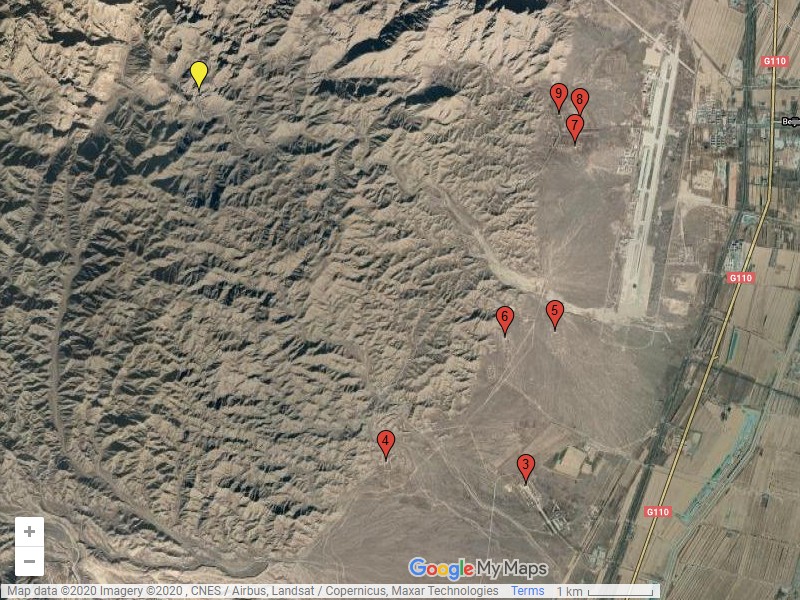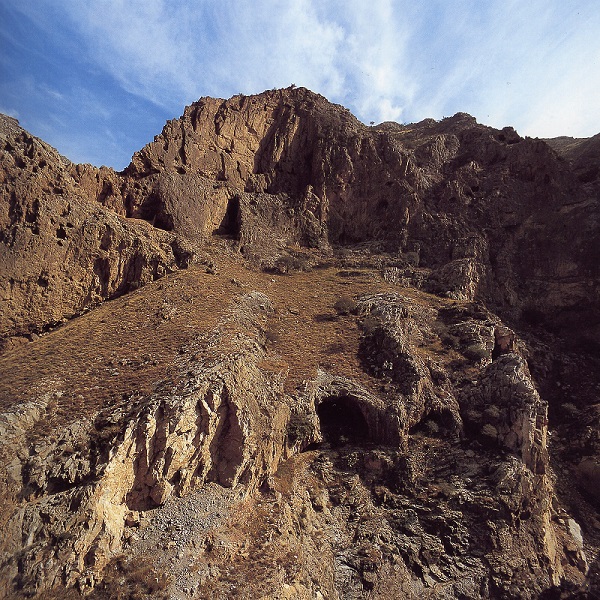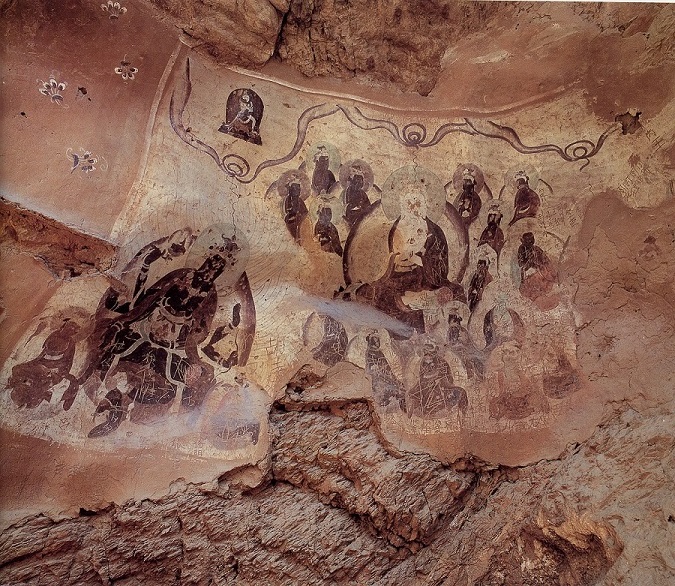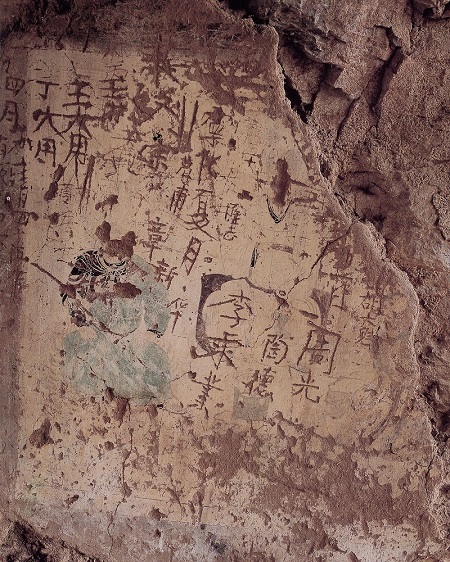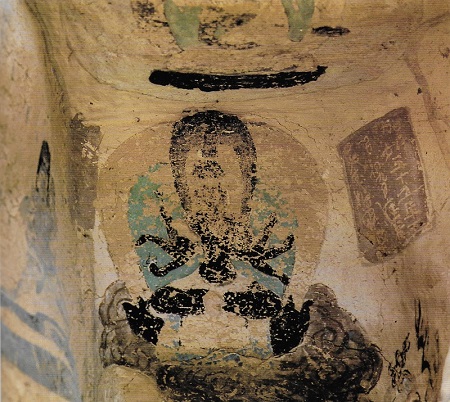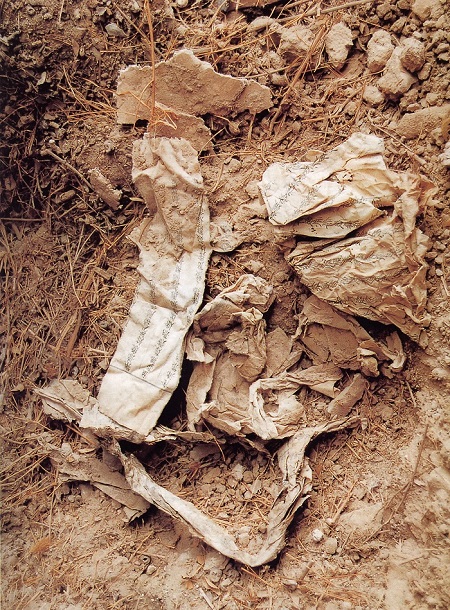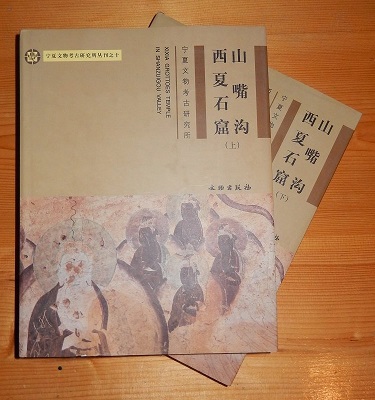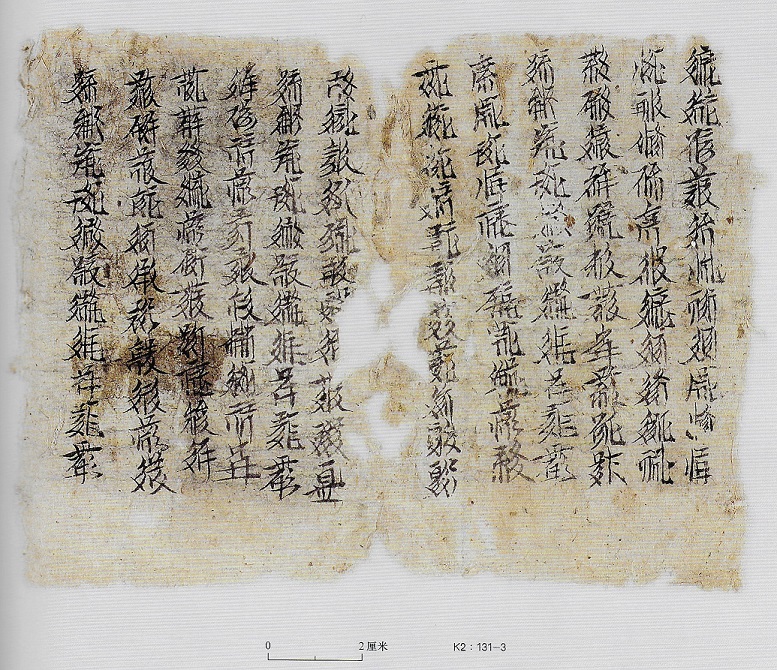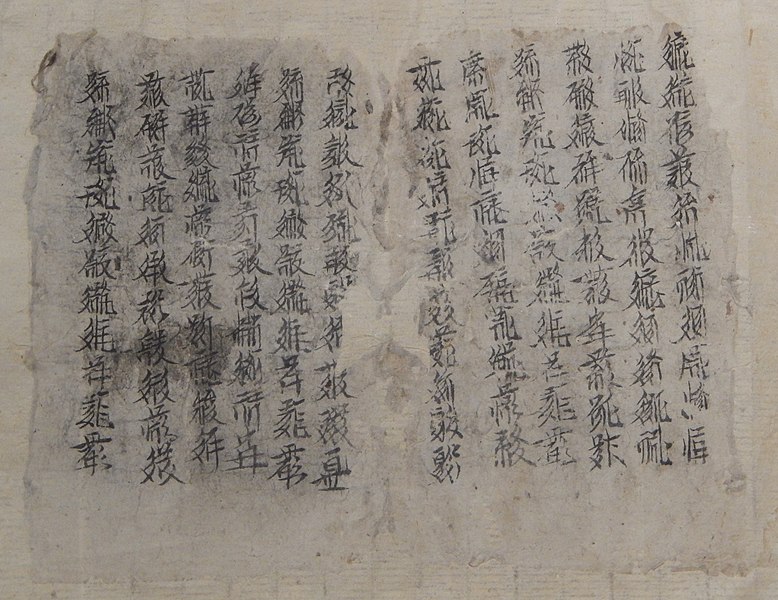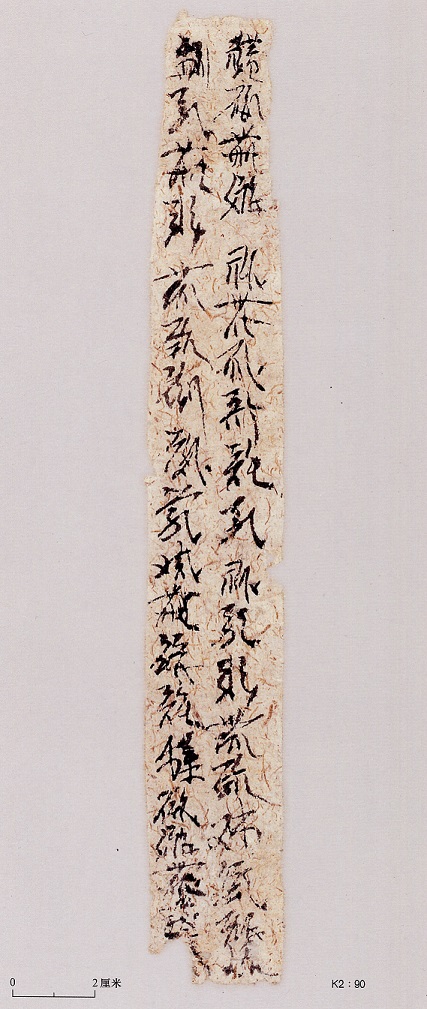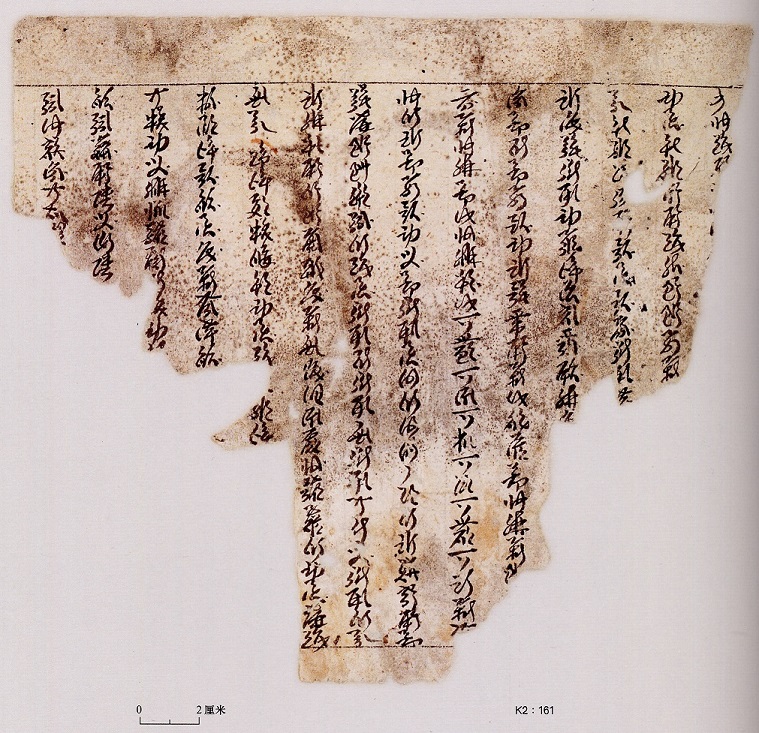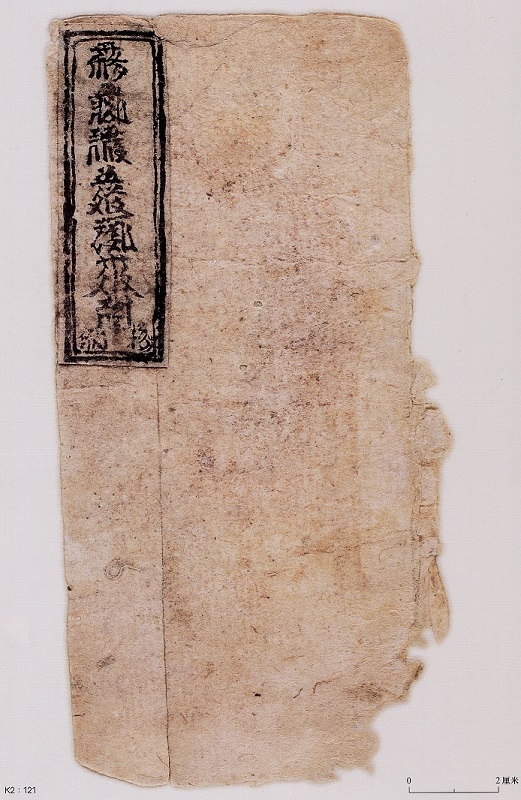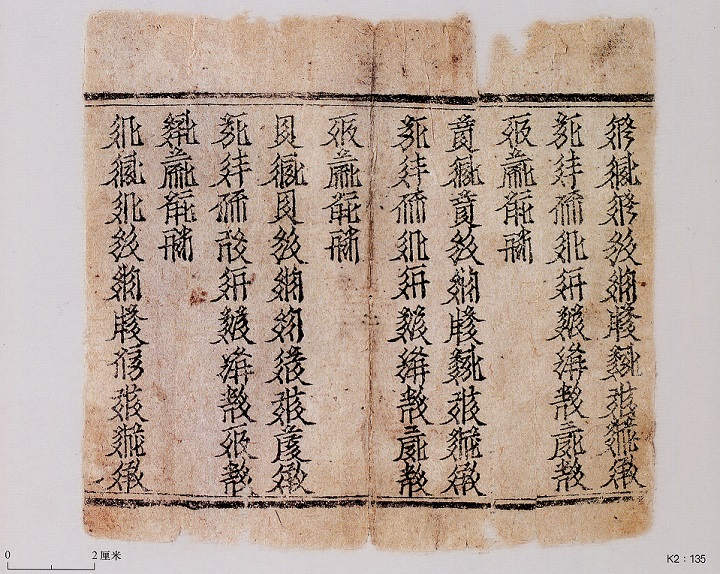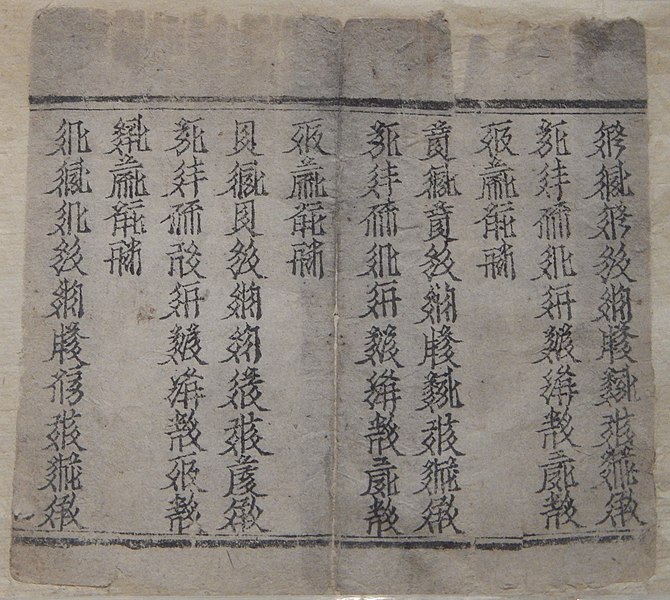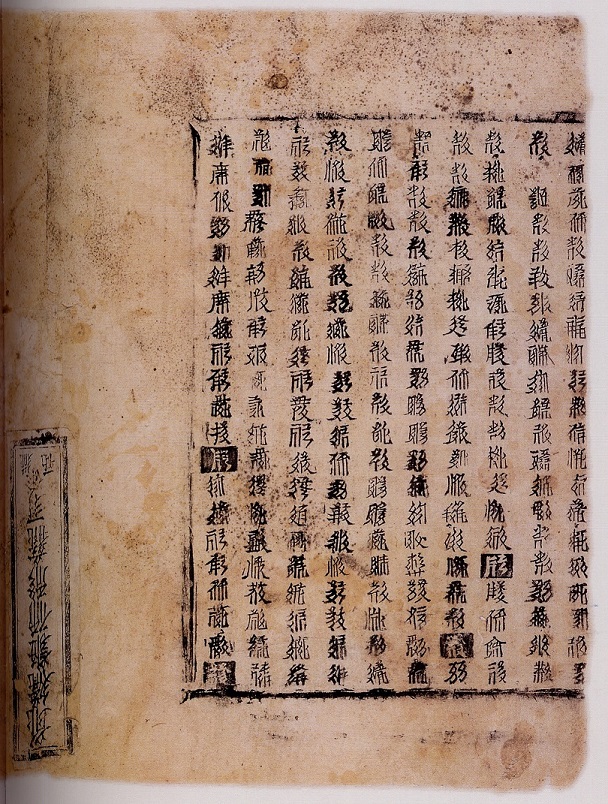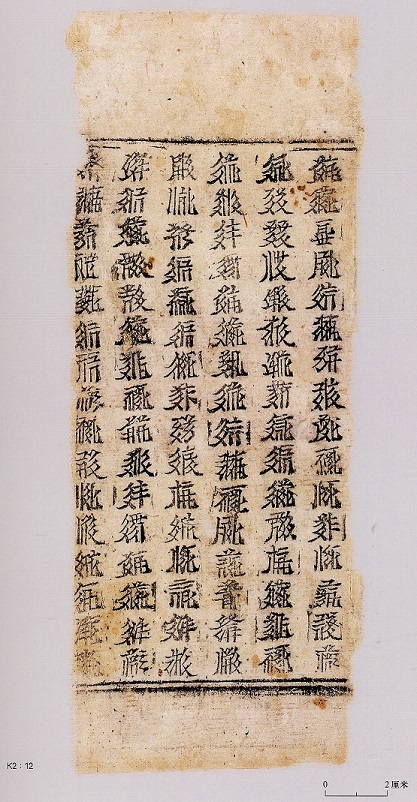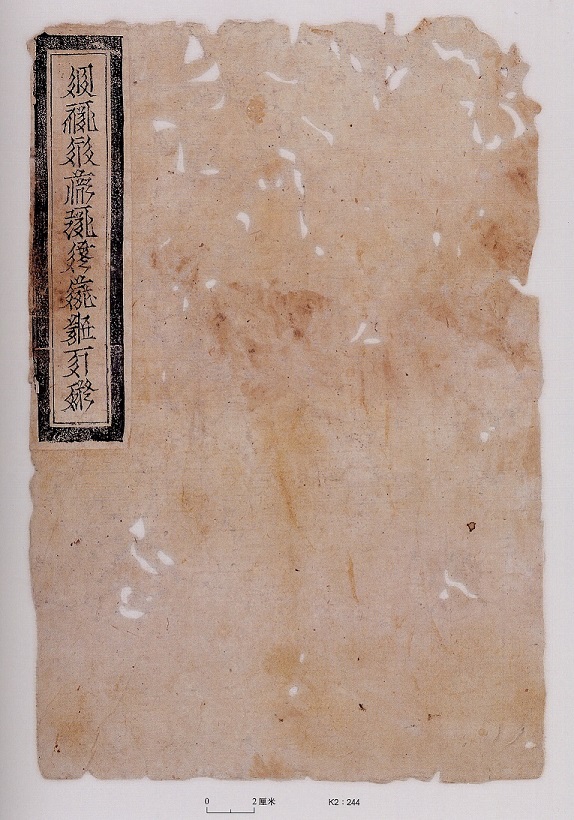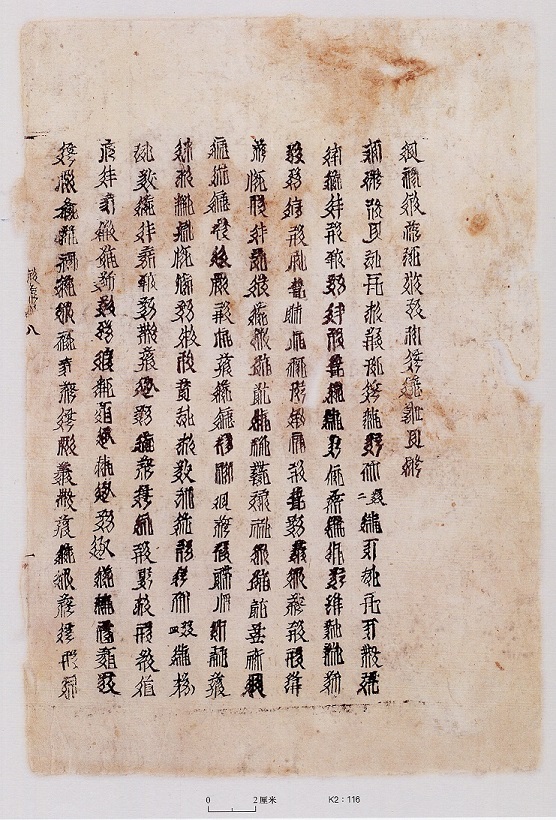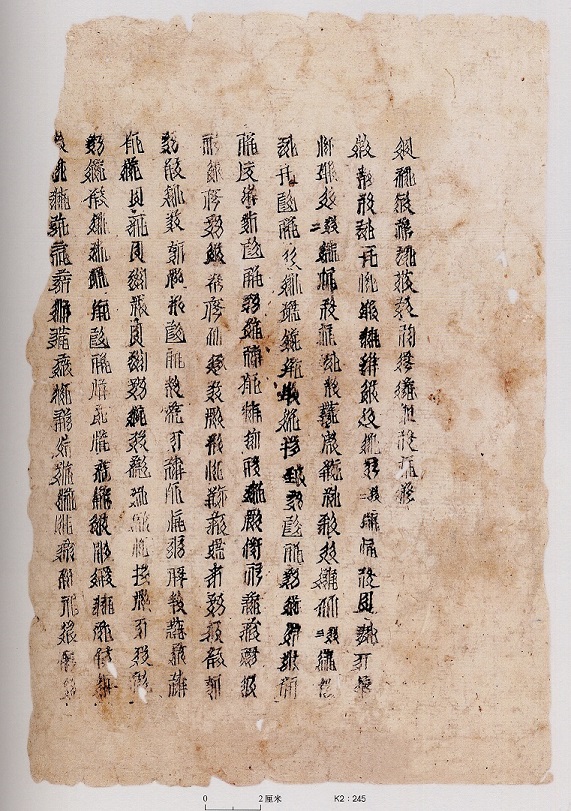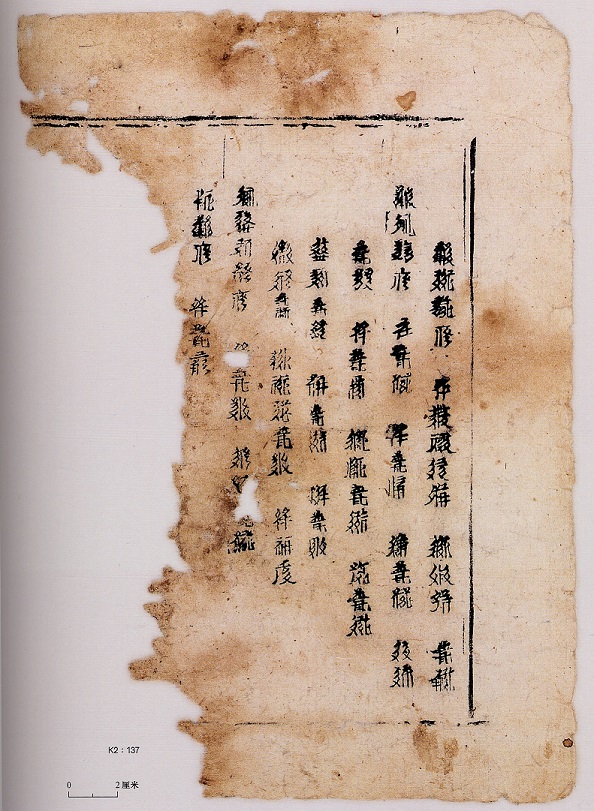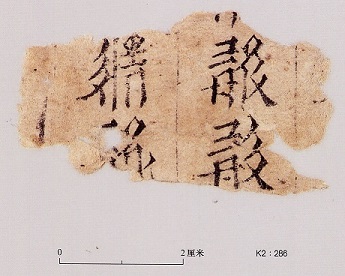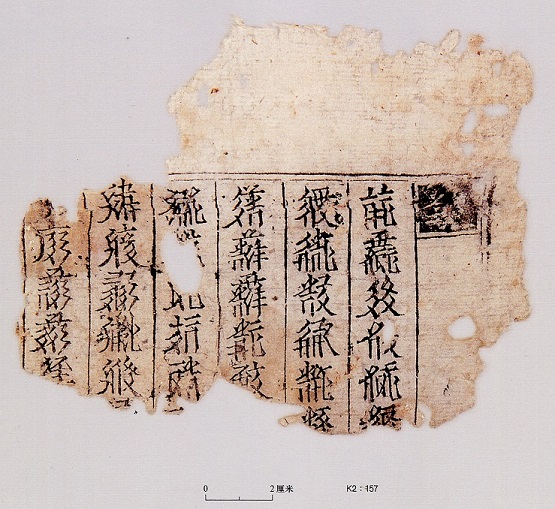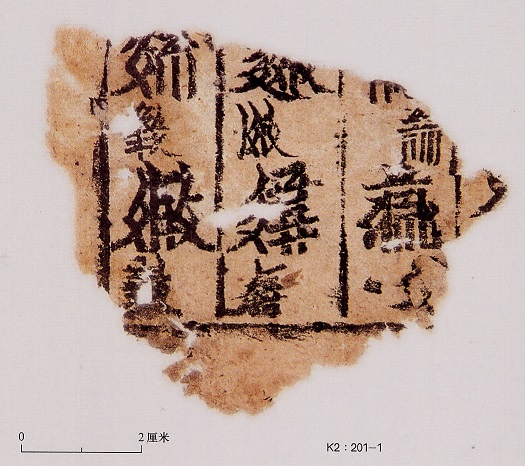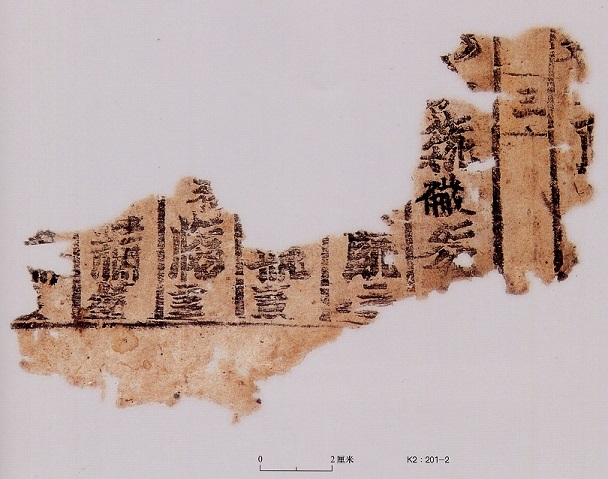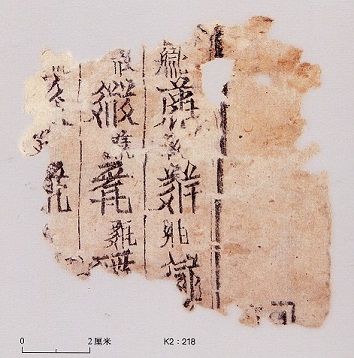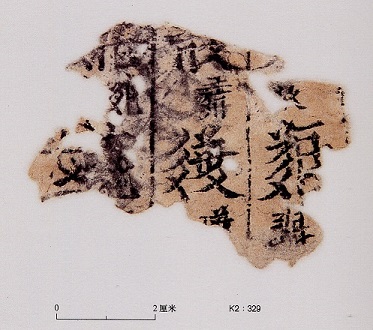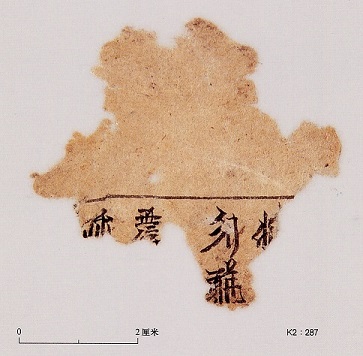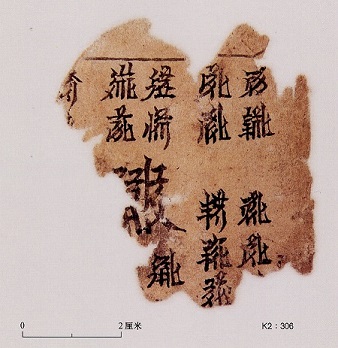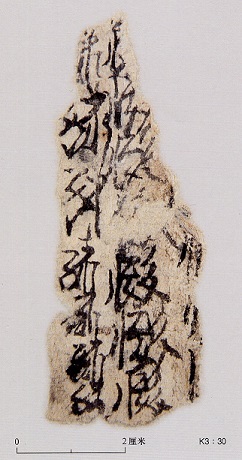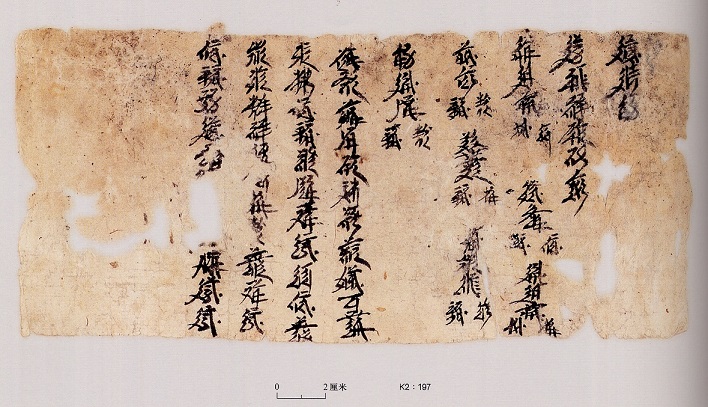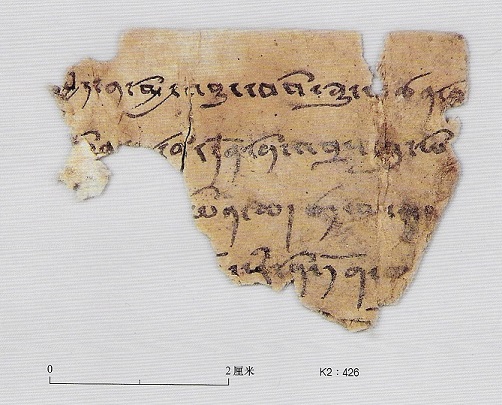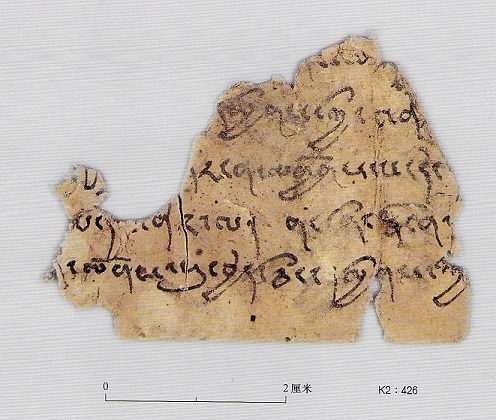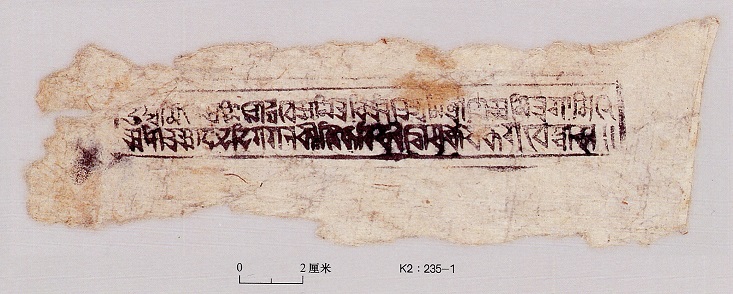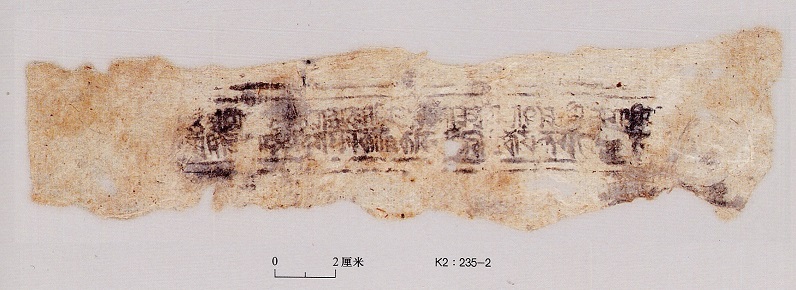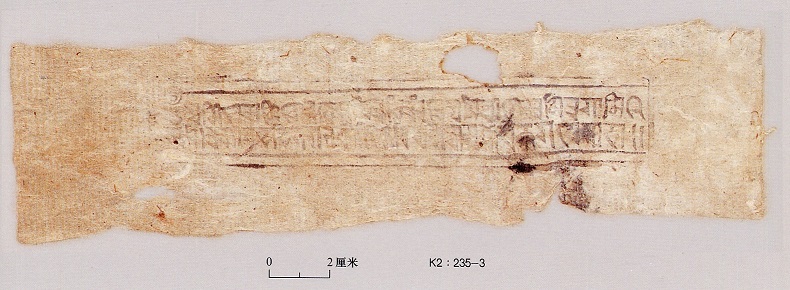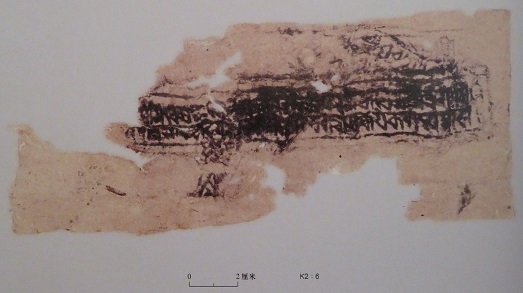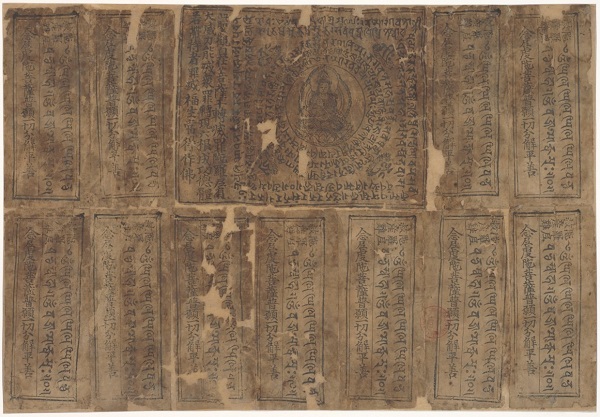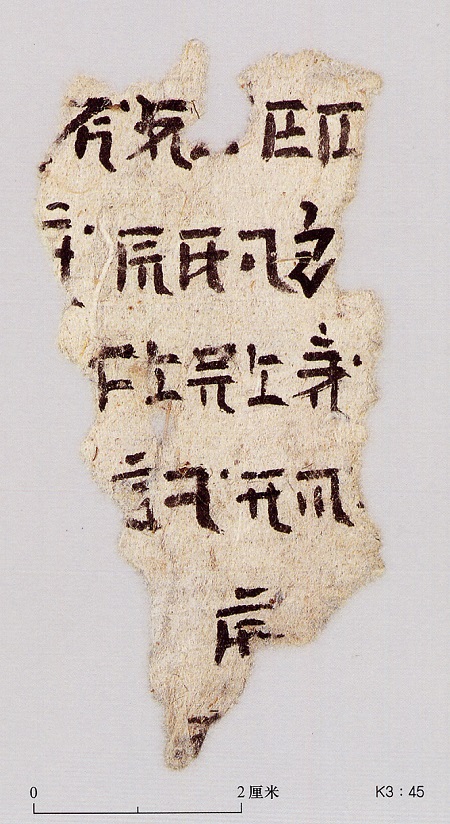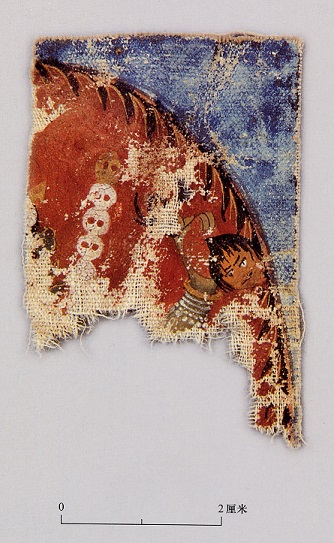BabelStone Blog
Tuesday, 7 July 2020
Tangut Discoveries at the Shanzuigou Caves
The Shanzuigou Caves (Shānzuǐgōu shíkū 山嘴沟石窟) are a Buddhist complex comprising six natural caves in the sides of a valley on the eastern flank of the Helan Mountains, about 20 km west of the centre of Yinchuan as the crow flies. Yinchuan is now the capital of the Ningxia Hui Autonomous Region of China, but nearly a thousand years ago it was the capital of the Western Xia kingdom (1038–1227) of the Tangut people.
The Shanzuigou valley opens onto the Ningxia plain by Tombs 5 and 6 of the Western Xia imperial tombs, about 7 km from the western edge of the urban centre, and the caves are reportedly situated about 10 km into the valley, although from the position given in Google Maps they seem to be closer to 8 km from the valley mouth along the winding valley.
Location of the Shanzuigou Caves
Yellow tag is the approximate location of the Shanzuigou Caves site
Red tags mark the Western Xia imperial tombs
These caves were first surveyed in 1984, but at the time it does not seem that their historical importance was fully appreciated, and the report merely notes that they must date to at least as early as the Ming dynasty as there were graffiti inscriptions with the dates Jiajing 13 [1534] and Longqing 2 [1568] on the murals in Cave K2.
View of the Shanzuigou Caves
Shānzuǐgōu Xīxià Shíkū Plate I
Upper level (left to right): Caves K3 (photo), K4, K2 (photo), K1 (photo)
Lower level (left to right): Caves K6 and K5
(Fig. 2 showing a plan of the caves)
In the summer of 2002, four member of the Ningxia Institute of Cultural Relics and Archeology (Dù Yùbīng 杜玉冰, Liào Yáng 廖旸, Zhū Cúnshì 朱存世, Sūn Chāngshèng 孙昌盛), and Xiè Jìshèng 谢继胜 from the Institute of Ethnology, Chinese Academy of Social Science, spent two days taking photographs and making a preliminary survey of the caves.
Buddhist Mural on Entrance Wall of Cave K3
Shānzuǐgōu Xīxià Shíkū Plate CCCXIV
Then in 2004 the Ningxia Institute of Cultural Relics and Archeology received permission from the National Cultural Heritage Administration to carry out a detailed investigation of Western Xia Buddhist sites on the eastern side of the Helan Mountains. The first stage of the project, led by Sūn Chāngshèng, lasted from late August to early October 2005 (the second stage was a topographic survey carried out in July 2006). The main purpose of the 2005 investigation was to survey the four caves on the upper level, and to photograph and draw their murals.
Buddhist Mural in Cave K1
Shānzuǐgōu Xīxià Shíkū Plate IV
Three figures sitting around an incense burner: the outline drawing of a monk reciting sutras in the centre; a painted military figure listening on the left; and the partial remains of another figure on the right.
Almost all the murals are heavily scratched over with senseless graffiti dating from the 16th to the 20th centuries.
Buddhist Mural in Cave K2
Shānzuǐgōu Xīxià Shíkū Plate XXIII
Eight-armed Avalokiteśvara seated on a lotus throne.
A text frame on the right has no original text, but has been over-inscribed with the date 9th day of the 5th month of the 35th year of the Jiajing era 嘉靖三十五年五月初九日 [25 June 1556 in the Julian calendar].
While preparing the ground outside Cave K2 for ladders in order to reach the highest murals, the team unexpectedly uncovered some Tangut Buddhist texts under the surface. Because of this discovery, they decided to clean the debris and earth inside the caves and around their entrances, which resulted in the discovery of a large number of text pages and fragments from caves K1 (17 pieces), K2 (544 pieces), and K3 (102 pieces). The vast majority of the discovered pieces were printed or manuscript Buddhist texts written in the Tangut script, and dating to the Western Xia period (1038–1227).
Tangut Buddhist texts as found in Cave K2
Shānzuǐgōu Xīxià Shíkū Plate XI
The results of the survey of the Shanzuigou site during 2005 and 2006 were published in 2007 as a two-volume book entitled Shānzuǐgōu Xīxià Shíkū 山嘴沟西夏石窟 (English abstract from vol. 1 pp. 350–352 is available online as Xixia Grottoes Temple in Shanzuigou Valley). Vol. 2 of the book comprises 335 colour plates of murals, texts and artefacts from caves K1, K2, K3, and K4. I was fortunate enough to buy a copy of this book in Hohhot on 26 August 2016.
A few interesting examples of Western Xia fragments and texts published in this book are shown below (in my opinion the pieces shown become more and more interesting the further down the page you go, and the most interesting piece is last of all).
Note that this book includes translations into Chinese of every single piece of Tangut text discovered at the site, but it does not give any Tangut characters, so all Tangut readings in this blog post are my own readings of the original Tangut texts, aided where necessary by the Chinese translations (which need to be used with care as they are not always totally correct).
A. Tangut Buddhist Texts
The vast majority of texts discovered at Shanzuigou are Buddhist texts written in the Tangut script. Most of these were recovered from Cave K2, with a smaller number of mostly small fragments found in caves K1 and K3. The texts are a mixture of manuscripts and printed texts, with both woodblock editions and movable type editions, although manuscripts account for the majority of the finds. From all three caves a total of 254 pieces representing 37 separate works of printed texts, and 396 pieces representing 127 separate manuscript texts, were recovered. These vary in size from small scraps with only a few characters on them to complete pages or sections of paper scrolls up to about 60 cm in length. No complete scrolls or fascicles were found. A large number of the manuscripts are translations of Tibetan Buddhist texts and/or are related to Tantric Buddhism.
A.1 Manuscript of a Tangut Translation of a Tibetan Text
There are so many different Tangut Buddhist manuscripts discovered at Shanzuigou that it is hard to decide which to include in this blog post. In the end I decided to choose some of the Tangut manuscripts that I saw in person on display at the Ningxia Museum in Yinchuan, which I visited on 18 August 2016 with my friends Viacheslav Zaytsev and Alla Sizova.
The first piece is one of three sheets from a concertina format manuscript of a previously unknown Tangut translation of a Tibetan Buddhist text found at Cave K2: K2:131-1 (4 folded sections); K2:131-2 (2 folded sections); and K2:131-3 (2 folded sections). The catalogue (Shānzuǐgōu Xīxià Shíkū vol. 1 p. 124) gives it the Chinese title Jíxiáng Rúshì Shūshèng Jīnyuàn Cǐ Ānlè 吉祥如是殊勝今願此安樂. This is a translation of the refrain 𘀄𘓄𗋕𗍊𗼩𘖃𗫈𗣜𘗐𘗲𗴴 ngi̯u ri̯ụ tha si̯u ꞏạ wạ sɪn thi̯u ndɪn no rại "Wish for peace and happiness for now that it is supremely auspicious like this"* which repeats every fourth line across the three sheets (4th, 8th, and 12th columns from the right on K2:131-3 shown below). The text is written clearly in regular (non-cursive) Tangut script, although the calligraphy is not particularly beautiful.
* This line is not easy to translate well. The word 𗼩𘖃 ꞏạ wạ is translated as yīnyuàn 因緣 "the happy fate which brings lovers together" in Li Fanwen's Tangut-Chinese dictionary, and it occurs with the character 𘀄 'lucky, auspicious' in the Tangut personal name 𗼩𘖃𘀄 ꞏạ wạ ngi̯u. However, in the Auspicious Tantra of All-Reaching Union this word occurs multiple times where it corresponds to the Tibetan word mchog མཆོག 'supreme, superior, excellent, eminent, outstanding, foremost, precious, finest, best, highest, sublime'.
K2:131-3
Shānzuǐgōu Xīxià Shíkū Plate CXXVIII
K2:131-3 on Display at the Ningxia Museum
BabelStone 🅭🅯🄎
A.2 Manuscript of a Tangut Dharani Text
The second piece is one of six paper strips found in Cave K2 which each have the same dhāraṇī text written in the same hand in cursive Tangut script in two columns (K2:25, K2:90, K2:93, K2:94, K2:99, K2:280). I saw K2:99 on display at the Ningxia Museum, but the catalogue only provides a colour plate for K2:90, which I show below.
K2:90
Shānzuǐgōu Xīxià Shíkū Plate CLXVIII
My photograph of K2:99 on display at the Ningxia Museum
The cursive Tangut script is not very neatly written, and it is difficult to read, even with six copies of the dhāraṇī text to compare. Shānzuǐgōu Xīxià Shíkū p. 150 transcribes the dhāraṇī text into Chinese characters as shown below (note that the K2:90 version is slightly different as the column breaks one character earlier than the other five examples, and it is missing the final few characters of the second column):
唵琵辟嘛犍□丕羅□伐犍都帝□底哆咦伽迦旃
ǎn pí bì má jiān [?] pī luó [?] fá jiān dū dì [?] dǐ duō yí qié jiā zhān
利辟頂辟底旃納尼□辟□哩鉢□摩訶尸哩摩捺
lì bì dǐng bì dǐ zhān nà ní [?] bì [?] lǐ bō [?] mó hē shī lǐ mó nà
However, this transcription is problematic in places, and my initial attempt to render it into Tangut characters was not entirely successful. The breakthrough came when Viacheslav Zaytsev recognised that it largely corresponds to the dhāraṇī known from its incipit as Ye dharmā hetu (apparently the authors of the Shanzuigou catalogue did not make this connection, which is why they were unable to fully and correctly transcribe the Tangut text into Chinese). The Tangut version of this dhāraṇī is engraved on the east wall of the mid-14th-century Cloud Platform at Juyong Pass, at the end of the Uṣṇīṣa-vijaya-dhāraṇī-sūtra (Chinese Fódǐng Zūnshèng Tuóluóní Jīng 佛頂尊勝陀羅尼經) "Dharani-Sutra of the Victorious Buddha-Crown" (cols. 25–27), whereas the Chinese version is engraved at the end of the Tathāgata-hṛdaya-dhāraṇī-sūtra (Chinese Rúláixīn Tuóluóní Jīng 如來心陀羅尼經) "Dharani-Sutra of the Tathagata Heart" on the west wall (cols. 20–21). It is also present at the end of the Tibetan text on the east wall, but does not occur in the surviving part of the Sanskrit text, and is absent from the Old Uighur and Phags-pa inscriptions.
The Tangut characters used for the Shanzuigou version of the dhāraṇī are not always the same as those engraved on the arch at Juyong Pass, but the parallel text did help Zaytsev and myself to fully (and hopefully correctly) read the cursive Tangut text on the Shanzuigou pieces. The table below compares the Sanskrit version of Ye dharmā hetu with the Shanzuigou version of the Tangut text, and the Juyong Pass versions of the Tangut and Chinese texts. The Sanskrit transcription is based on that given by Nishida Tatsuo 西田龍雄 in his transcription of the Tangut text of the Juyong Pass inscriptions (Murata 1957, p. 183). The reconstructed readings for Tangut characters here and elsewhere in this post are those of M. V. Sofronov as given in E. I. Kychanov's 2006 Tangut dictionary. They should be treated as only an approximation of how Tangut was really pronounced, and in some cases the reconstructions are not a good phonetic match for the corresponding Sanskrit sound.
| Sanskrit Transcription | Tangut Text | Chinese Text | ||||
|---|---|---|---|---|---|---|
| Shanzuigou Version | Juyong Pass Version | |||||
| Tangut | Reading | Tangut | Reading | Chinese | Pinyin | |
| om̐ | 𗙫 |
ꞏa | 𗙫 |
ꞏa | [唵] |
[ǎn] |
| ye | 𗗟 |
ꞏɪn | 𗶾 |
ꞏɪn | 曳 |
yè |
| dharmā | 𗞞𗏵 |
nda ma | 𗞞𗏵 |
nda ma | [達]哩麻 |
[dá] lǐ má |
| hetu- | 𗙕𗚓 |
xa ti̯u | 𗙕𗅥 |
xa ti̯u | 呬都 |
xì dū |
| prabhavā | 𗟱𘃜𘄍𘎧 |
pɪ ri̯ạ mba wa | 𗟱𘃜𗍣𘎧 |
pɪ ri̯ạ mba wa | 巴囉杷[哇] |
bā luó pá [wā] |
| hetuṃ | 𗙕𗯪 |
xa ti̯u | 𗙕𗅥 |
xa ti̯u | 呬□ |
xì [?] |
| teṣāṃ | 𘄿𗜓𘆄 |
tɪn śi̯a nɪ | 𘄿𘛣𘆄 |
tɪn śi̯a nɪ | 的扇 |
dí shàn |
| tathāgato | 𘈪𗏤𘕜𗧊 |
ta tha nga to | 𘈪𗏤𘕜𘛵 |
ta tha nga to | 荅塔誐□ |
dá tǎ é [?] |
| hy avadat | 𘜤𘎧𗞞 |
xi̯a wa nda | 𗙕𘎧𘈪□ |
xa wa ta | □□□□ |
[? ? ? ?] |
| teṣāṃ | 𘄿𗜓𘆄 |
tɪn śi̯a nɪ | 𘄿𘛣𘆄 |
tɪn śi̯a nɪ | □□ |
[? ?] |
| ca | 𗉅 |
tsa | 𗉅 |
tsa | 拶 |
zā |
| yo | 𗭴 |
ꞏi̯on | 𗑁 |
ꞏôn | 余 |
yú |
| nirodha | 𗐱𗨨𗞞 |
ni rụo nda | 𗐱𗨨𘃕 |
ni rụo ndi̯a | 尼盧塔 |
ní lú tǎ |
| evaṃ | 𗖛𘄍 |
ꞏi̯e mba | 𗙕𗺑𗕘 |
xa mbi̯a | □□ |
[? ?] |
| vādī | 𗴟𘆨 |
pa ti | 𗍣𗿿 |
mba ndɪn | □帝 |
[?] dì |
| mahā- | 𗏵𗶴 |
ma xa | 𗏵𗶴 |
ma xa | 麻訶 |
má hē |
| śramaṇaḥ | 𗶹𘃜𗏵𘉞 |
śi̯e ri̯ạ ma na | 𗶷𘃜𗏵𘀍 |
śi̯ə ri̯ạ ma na | 室囉麻𨚗 |
shì luó má nà |
This dhāraṇī was very popular, and in addition to the version engraved at Juyong Pass, we know of thirteen hand-written Tangut examples on paper strips from Kharakhoto and other Western Xia sites. There is also a fragment of a woodblock printed edition, found at the Haimu Cave site in Gansu (see Duàn Yùquán 2011), which gives the Tangut title as 𘔼𗄈𗥺𗖸 ni̯uo śi̯o ngwə ngwu "Incantation on dependent arising", but unfortunately only the first nine characters of the dhāraṇī are preserved.
A.3 Manuscript of a Buddhist Text
The third piece, also from Cave K2, is one of 27 sheets and fragments from a manuscript scroll of what is probably a commentary on a Tibetan tantric text. The text is written in a very cursive Tangut script which is very beautiful but also very hard to read.
K2:161
Shānzuǐgōu Xīxià Shíkū Plate CCLI
A.4 Woodblock Edition of a Buddhist Text
Diamond Sutra Collected 𗵒𘗁𘄒𘎑𗖰𗚩𗰖 kẹi ndźi̯a pa źi̯a lwə̣ rại śi̯oɯ (Chinese Jīngāng Bōrě Jīngjí 金剛般若經集) is a fairly typical example of a woodblock edition of a Buddhist text. The front cover, two whole leaves, and three fragments of this text were found in Cave K2. It is supposedly the same edition as a printed version held at the IOM, but I cannot find an exact match for this title in the 1999 Catalogue of Tangut Buddhist Texts in the IOM (the closest title is a manuscript edition).
K2:121
Shānzuǐgōu Xīxià Shíkū Plate XXX
Front cover of Diamond Sutra Collected with title slip
K2:135
Shānzuǐgōu Xīxià Shíkū Plate XXXII (1)
Leaf from Diamond Sutra Collected with instructions for prostrating nine times to the Buddha at dawn on the 6th day of the 6th month, on the 7th day of the 7th month, the 8th day of the 8th month, and the the 9th day of the 9th month.
K2:135 on Display at the Ningxia Museum
BabelStone 🅭🅯🄎
A.5 Buddhist Text Printed with Baked Clay Movable Type
Brief Explanations on the Exegesis of Complete Enlightenment Part 1 First Half 𘍞𗫨𘋓𗗙𘓋𗔡𘈩𘁷𗨁𗸕 ꞏwọn ndwẹɯ ngi̯ə ꞏɪn źi̯on li̯ə̣ leɯ ndzạ phi̯u khwə (Chinese Yuánjué Zhù zhī Lüèshū dìyī shàngbàn 圓覺注之略疏第一上半) is a previously unknown Buddhist text, printed using baked clay movable type. Fourteen fragments of this text were found in Cave K2, the largest one (shown below) with a woodblock-printed title slip.
K2:129
Shānzuǐgōu Xīxià Shíkū Plate XXXIV
Page of Brief Explanations on the Exegesis of Complete Enlightenment with upside down title slip
The inverse text characters 𗡺 'note' and 𘃪 'end' delimit the start and end of the commentary. The comment on the last column of this page reads 𗡺𗦻𗫂,𗟲𘒣𗗙𗵘𘟂。𘃪 (= Chinese 注名者,語言之道也。終) "Note Names are the way of language End".
This leaf shows some typical features of movable type printing with baked clay type pieces (the first seven features also apply to printing with wooden type pieces):
- The edges of the frame enclosing the text do not meet at the corners (this is typical of all forms of movable type printing, but is never seen in woodblock printing);
- The characters are not lined up neatly within a vertical column (the bottom part of the 6th column from the right is a good example of characters not aligning well on the vertical axis);
- Some of the characters are not fully vertical, but are slanted at an angle (e.g. bottom character of 6th column from the right);
- The characters vary in size, some smaller, some larger;
- The characters have varying stroke thickness;
- The same characters do not all have consistent glyph forms (compare the distinctly different ways of writing the left part of the character 𘌅 when it is reduplicated towards the bottom of the 2nd column from the right; and the right part of the character 𘉕 when it is reduplicated in the middle of the 5th column from the right);
- Some characters are only lightly inked, and in some cases half of the character has not been printed (e.g. the 10th character of the 9th column from the right [𗪆]), which is presumably due to the type piece not being level;
- Some characters are very heavily inked, which is a particular feature of printing with baked clay type, and is thought to be due to the clay type pieces being over-baked, resulting in glazing which causes the ink to spread out (Shānzuǐgōu Xīxià Shíkū vol. 1 p. 320);
- Some characters have missing parts of strokes where the brittle clay type piece has been damaged during handling (e.g. the character 𗦻 on the 10th column which is missing the end part of the stroke on the bottom left) [this phenonemon is most obvious when the same damaged type piece is used on different pages as shown by this example from a Tangut Buddhist text printed with baked clay movable type held at the IOM];
- Some characters show tiny white spots which are caused by air bubbles forming at the surface of poor quality clay when it is baked (Shānzuǐgōu Xīxià Shíkū vol. 1 p. 320) [this page does not have any good examples of this phenonemon, but it is frequently seen in the movable type edition of Annotated Mirror on the Essential Collected Meanings of the Wonderful Dharma Lotus Flower Sutra discussed below, for example in this detail of Plate XXXVIII);
A.6 Buddhist Divination Text Printed with Movable Type
One complete leaf and one small fragment of a previously unknown Tangut translation of the Chinese Buddhist divination text Zhānchá Shàn'è Yèbào Jīng 占察善惡業報經 "Sūtra of Divination to Examine the Karmic Retribution" [T839] were found in Cave K2.
K2:12
Shānzuǐgōu Xīxià Shíkū Plate XLIV
Page of Buddhist divination text printed using movable type
The Tangut title of this text is not preserved, but the source of the translation has been identified because the Tangut text on K2:12 corresponds closely to part of vol. 2 of 占察善惡業報經 [T839]. Here is a transcription of the Tangut text in parallel with the corresponding Chinese text:
| Column | Tangut | Chinese |
|---|---|---|
| 1 | 𘌽𗫂𘞗𗎫𗼻𗖵𗉘𘅍𗱕𗹙𗅋𘎳𗅋𗈞𘄎𗑗 | 所謂依種性地,決定信諸法不生不滅,清淨 |
| 2 | 𗣼𗳦𘙌𗅆𘓟𗳒𘓞𗴿𗦇𗤋𗫂𘟂𗍫𗫂𘏋𗹙 | 平等,無可願求故。二者,解滿法 |
| 3 | 𗥤𘔼𗢳𗨻𘌽𗫂𘝦𗥤𗼻𗖵𗹙𗎫𗓰𘟛𗌮𗆐 | 故作佛。所謂依解行地,深解法性,知如來 |
| 4 | 𘈽𗄻𘃡𗤋𘃨𗤋𗢠𘎳𘈬𗦺𗍫𗾫𗅋𗄈𗤶𗴒 | 業無造無作,於生死涅槃不起二想,心 |
| 5 | 𗃬𗤋𗫂𘟂𘕕𗫂𘏋𗹙𘕥𘔼𗢳𗨻𘌽𗫂𗤶𗑗 | 無所怖故。三者,證滿法故作佛。所謂依淨心 |
| 6 | 𗼻𗖵𘝵𗠷𗞕𗤋𗘺𗑗𗹙𘄡𗅉𗅢𗾫𗣓𗋕𗡶 | 地,以得無分別寂靜法智,及不思議自然 |
This is obviously an edition printed with movable type because the characters are not neatly aligned along the vertical axis, and the characters are not a consistent size. Moreover, there is a short vertical line on one or both sides of many of the characters, which is supposedly due to the edge of the type piece sticking up and so being inadvertently inked (Shānzuǐgōu Xīxià Shíkū vol. 1 p. 320). I am not convinced by this explanation as it seems unlikely to me that the edges of the type pieces would be raised (and if so, why only the sides, and not the top and bottom edges?). My suggestion is that the short vertical lines are the traces of bamboo or wooden slips inserted to the side of loosely-fitting type pieces to hold them tightly in place. In any case, these short vertical lines are certainly indicators of movable type.
The authors of the catalogue (Shānzuǐgōu Xīxià Shíkū vol. 1 p. 320) conclude that this edition was set using wooden movable type rather than baked clay type, on the basis that the characters are neat and well-defined, with smooth and sharp strokes, and that there are very few broken strokes (due to damaged type pieces). The characters found in editions set with baked clay type are supposedly less well-defined with coarse, blunt strokes (Bàisìgōu Xīxià Fāngtǎ p. 358; Shānzuǐgōu Xīxià Shíkū vol. 1 p. 320), but I suspect that these are not universal traits found in all baked clay type editions, but are only distinctive in some poor quality editions, and so I doubt that these are good criteria on which to decide whether a movable type edition was printed using baked clay type or wooden type. Indeed, there are other factors that could influence the appearance of the printed characters, such as the quality of the materials (whether wood or clay), the skill and experience of the type makers, and wear and tear on the type pieces.
I do think that the presence of missing and broken strokes is a strong indicator of baked clay type, and I note that broken strokes are extremely common in Collected Writings of the Shining Speech of Three Generations 𘕕𗤀𘎆𗮔𗟲𗰖𘝞 sọ śiei̯ ndźwɪ sweɯ ngwu śio̯ɯ ꞏiw̯ə̣ (Chinese Sānshìshǔ Míngyán Jíwén 三世屬明言集文 or Sāndài Xiāngzhào Yán Wénjí 三代相照言文集) [IOM Tang. 27] which the authors of the catalogue (Shānzuǐgōu Xīxià Shíkū vol. 1 p. 320) consider to be a wooden movable type edition, but which I believe to be printed using baked clay type. However, one complete page of six columns and one small fragment are not a large enough sample of text to indicate whether broken strokes are prevalent in the Shanzuigou divination text.
The only strong argument for this edition being printed using wooden type would be if the short vertical lines next to the characters only occur in wooden movable type editions, and never in editions set using baked clay movable type, which is a question that I do not know the answer to (actually there is a single example to the left of the character 𗏇 at the top right of K2:137 shown further below). Niú Dáshēng 牛达生 (Bàisìgōu Xīxià Fāngtǎ pp. 357–358) states that one of the features of the Buddhist tantric text Auspicious Tantra of All-Reaching Union 𘀄𘓄𗄊𗫡𗋈𘜼𗰜𗺓 ngi̯u ri̯ụ źi nɪ ngwu phi̯oɯ mə twẹi (Chinese Jíxiáng Biànzhì Kǒuhé Běnxù 吉祥遍至口和本續) which indicates that it was printed using wooden type rather than baked clay type is the ocasional presence of long thin lines between columns of text, especially where there are large areas of blank text, which is caused by bamboo separators placed between the columns sometimes protruding so that they are inadvertently inked (actually we can also an example of this long thin separator line in the blank space at the top of K2:137 which is supposedly printed using baked clay type). The short vertical lines seen in this divination text seem to be different to the long vertical lines seen in Auspicious Tantra of All-Reaching Union, so perhaps short bamboo or wooden slips could have been used to hold either either wooden or baked clay type pieces in place.
This edition also shows some features that are supposed to be typical of baked clay movable type. Firstly, some of the characters are very heavily inked (e.g. top character of the 2nd column from the right), which is supposed to be caused by over-baking of clay type pieces. Secondly, many of the characters show tiny white spots, which is supposed to be caused by air bubbles forming when the clay is baked — but maybe here they have a different origin. All in all, I am not convinced that this is a wooden movable type edition, and feel that better criteria for distinguishing wooden type and baked clay type need to be developed.
A.7 Buddhist Text Printed with Baked Clay Movable Type
Annotated Mirror on the Essential Collected Meanings of the Wonderful Dharma Lotus Flower Sutra 𗤓𗹙𗤻𗑗𗖰𗚩𘄴𗰖𗧘𗪼𘋓 thi̯oɯ tsɪ̣ vi̯ạ sei lwə̣ rại tshi śi̯oɯ wo tɪ̣ ngi̯ə (Chinese Miàofǎ Liánhuá Jīngjí Yàoyì Jìngzhù 妙法蓮華經集要義鏡注) is a previously unknown Buddhist text, printed using baked clay movable type. Sixty-eight pages and fragments of this text were found in Cave K2.
K2:244
Shānzuǐgōu Xīxià Shíkū Plate XLVI
Front cover of Annotated Mirror on the Essential Collected Meanings of the Wonderful Dharma Lotus Flower Sutra Part 1
K2:116
Shānzuǐgōu Xīxià Shíkū Plate XLVII
Annotated Mirror on the Essential Collected Meanings of the Wonderful Dharma Lotus Flower Sutra Part 8
K2:245
Shānzuǐgōu Xīxià Shíkū Plate XLVIII
Annotated Mirror on the Essential Collected Meanings of the Wonderful Dharma Lotus Flower Sutra Part 12
My photograph of this sheet on display at the Ningxia Museum
K2:137
Shānzuǐgōu Xīxià Shíkū Plate LXX
Annotated Mirror on the Essential Collected Meanings of the Wonderful Dharma Lotus Flower Sutra end page
The end page (presumably of the last volume of the book) shown above (K2:137) is of particular interest as it lists all the people involved in the production of the printed book, as transcribed below (Chinese translations from Shānzuǐgōu Xīxià Shíkū vol. 1 pp. 318–319 with a couple of changes).
| Tangut | Chinese | English |
|---|---|---|
| 𘟩𘅞𘜏𗇋 | 印面校者 | Those who checked the print blocks:- |
| 𗃛𗷅𗡝𗥰𗏵 | 梁釋迦喇嘛 | Li̯on Śākya Lama |
| 𗼨𗏡𗊠 | 嵬古竭 | Ngwe Kụ-ngɪn |
| 𘟛𘇚 | 慧治 | Wisdom-governs |
| 𘟩𗏇𘏲𗇋 | 印字取者 | Those who selected the characters for printing:- |
| 𗃛𘟛𗮔 | 梁慧照 | Li̯on Wisdom-shines |
| 𗃛𘟛𗹡 | 梁慧勇 | Li̯on Wisdom-is-brave |
| 𗌔𘟛𗮔 | 段慧照 | Thwan Wisdom-shines |
| 𗣆𘀄𘟛𗯿 | 錢玉慧盛 | Tsha-ngi̯u Wisdom-flourishes |
| 𗃛𘟛𗵆 | 梁慧成 | Li̯on Wisdom-accomplishes |
| 𗼨𗆟𘟛𗩴 | 嵬名慧善 | Ngwe-mi Wisdom-is-good |
| 𗭴𘟛𗩱 | 楊慧能 | ꞏi̯on Wisdom-is-able |
| 𗶣𘏤𘟛𗯿 | 米勒慧盛 | Me-ldi̯ẹ Wisdom-flourishes |
| 𘃣𘟛𗩴 | 魏慧善 | Vi̯e Wisdom-is-good |
| 𗱈𘟛𘉍 | 勒慧明 | Lde Wisdom-is-bright |
| 𗬢𗤂𘟛□ | 甲狄慧□ | Ngwɪ-ndi Wisdom- [?] |
| 𗗧𗙴𗳩𘟛𘏨 | 賈羅訛慧寶 | Kâ-rạ-ꞏo Wisdom-is-precious |
| 𗃛𗹏𗘦 | 梁那徵 | Li̯on Ndon-ndźɪn |
| 𗏇𗶦𘄱𘃡𗇋 | 作字兼丁者 | Those who made the characters and the type pieces:- |
| 𗃛𘟛𘏨 | 梁慧寶 | Li̯on Wisdom-is-precious |
| 𗤂□𘟛𗮔 | 狄□慧照 | Ndi-[?] Wisdom-shines |
| 𗺉𘟩𗇋 | 印本者 | Those who printed the books:- |
| 𗃛𘟛𗕎 | 梁慧安 | Li̯on Wisdom-is-peaceful |
The people listed are all Buddhist monks, most with a religious name begining 'Wisdom'. Their secular family name is given to distinguish them in most cases. Seven of them bear the family name Li̯on 𗃛 which corresponds to the Chinese family name Liang 梁, but this is not unusual is it seems from other sources to have been on of the most common Western Xia family name. The four roles mentioned clearly refer to printing using movable type (no mention of anyone engraving the text as is found in the colophons to woodblock editions):
- 𘟩𘅞𘜏 "checking the print blocks" (elsewhere 𘟩𘅞 'print face' refers to xylographic woodblocks, but here it presumably refers to the printing frame for a page after all the type pieces have been set in it) — three people, one of whom (Liang Śākya Lama) sounds like a senior monk, were responsible for the job of checking the completed printing frame;
- 𘟩𗏇𘏲 "selecting the characters for printing" — the job of selecting the type pieces and perhaps also setting the type pieces in the printing frame required as many as thirteen people, which sounds excessive but they may have had different tasks, and it is likely that more than one page would be set up at a time;
- 𗏇𗶦𘄱𘃡 "making the characters and the type pieces" — the exact interpretation of the Tangut is not certain but it seems unlikely that only two people would be needed to make the type pieces, although maybe they only made additional type pieces occasionally when the existing stock of type pieces was not sufficient (alternatively this may refer to setting the type pieces in the printing frame);
- 𗺉𘟩 "printing the book" — the actual printing onto paper was apparently carried out by a single person.
B. Tangut Lexical Texts
A few fragments of Tangut lexical texts were also found in Cave K2. It is not uncommon to find such texts in Buddhist contexts, but it is a shame that only a few fragments survived, especially the unique woodblock edition of the Synonyms.
B. 1 Fragments of Synonyms
Two fragments of a woodblock printed edition of Synonyms 𗧘𘙰 wo leɯ (Chinese Tóngyì 同義) were found in Cave K2. The Institute of Oriental Manuscripts (IOM) in Saint Petersburg holds one almost complete manuscript (Tang. 24) and one partial manuscript of Synonyms, but as far as I know no printed version of the text has previously been found.
K2:286
Shānzuǐgōu Xīxià Shíkū Plate CCXCI (1)
Synonyms fragment (part of folio 29B cols. 6–7)
K2:157
Shānzuǐgōu Xīxià Shíkū Plate CCXC
Synonyms fragment (top of folio 11A cols. 1–7)
The larger fragment has the same layout and column positions as folio 11A of the manuscript text (Tang. 24), which suggests that the manuscript is a copy of the printed edition.
IOM Tang. 24 folio 11A
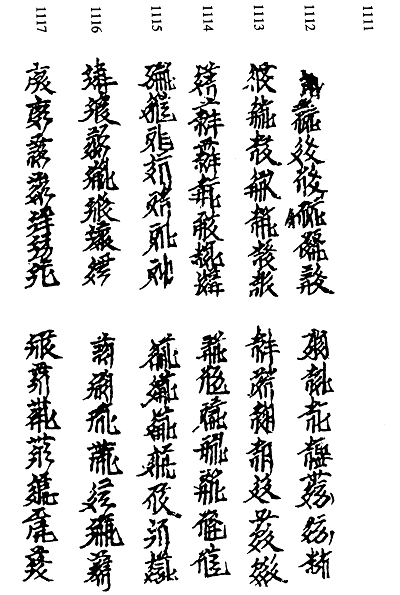
The manuscript is missing the head character (𘕤) printed in inverse text in col. 1 of the Shanzuigou fragment, but this character is present in the list of Synonyms head characters preserved in Homonyms (as I discuss in a forthcoming edition of this text).
B.2 Fragments of Homophones
Four fragments of a woodblock printed edition of Homophones 𗙏𘙰 ꞏệi leɯ (Chinese Tóngyīn 同音) were found in Cave K2. These belong to the more common 'B' recension of the text, and do not provide any new material, but it is alway nice to see more fragments of Homophones (the British Library collection has about 80 fragments of the 'B' recension, and two small fragments of the 'A' recension).
K2:201-1
Shānzuǐgōu Xīxià Shíkū Plate CCXCI (2)
Homophones B folio 4A cols. 4–7
K2:201-2
Shānzuǐgōu Xīxià Shíkū Plate CCXCII
Homophones B folio 3A col. 7 and folio 4A cols. 1–6
Note that the pagination here uses Chinese characters
(some Homophones B editions use Tangut page numbers, some use Chinese page numbers)
K2:218
Shānzuǐgōu Xīxià Shíkū Plate CCXCIII (1)
Homophones B folio 29A cols. 1–3
K2:329
Shānzuǐgōu Xīxià Shíkū Plate CCXCIII (2)
Homophones B folio 28B cols. 2–4
B.3 Fragments of Combined Edition of Homophones and Precious Rimes of the Sea of Writing
Two fragments of a manuscript of the combined edition of Homophones and Precious Rimes of the Sea of Writing 𘝞𗗚𘏨𗖵 ꞏi̯wə̣ ngôn ldi̯ə̣ mbi̯u (Chinese Wénhǎi Bǎoyùn 文海寶韻) were found in Cave K2. This text is only know from several incomplete manuscript copies and manuscript fragments originally from Khara-Khoto, and now held at the IOM and the British Library. I believe that these two fragments from Shanzuigou are the only remains of this text to have been found in recent years. I find it strange that several manuscript versions and fragments of this combined text of Homophones and Sea of Writing have survived, and many fragments of the woodblock printed edition of Homophones have been found, yet not a single fragment of the woodblock printed edition of Sea of Writing has ever been discovered.
K2:287
Shānzuǐgōu Xīxià Shíkū Plate CCXCIV (2)
Fragment of the combined edition of Homophones and Sea of Writing
K2:306
Shānzuǐgōu Xīxià Shíkū Plate CCXCIV (1)
Fragment of the combined edition of Homophones and Sea of Writing
These two fragments join together (K2:306 on the left and K2:287 on the right), and together preserve the tops of four columns of text. The larger fragment shows the head character 𘏪, and the two fragments together correspond to the entries for the eight characters 𗠲 through 𘎭 in Homophones B folio 20B cols. 5–6. None of the other surviving manuscripts or fragments of the combined edition cover these eight entries, so the Shanzuigou fragments are important. Unfortunately they are too small and fragmentary to be of much help in reconstructing the text of the combined edition.
B.4 Practice Piece from Mixed Characters
One small scrap of paper from Cave K3 appears to be the remnants of a practice piece for writing Tangut characters by a student monk. The scrap only preserves two columns of about seven squashed and untidy characters, with the same character repeated over and again on each column: 𗆃 pụ 'weft' repeated down the right column, and 𗉖 tshi̯e 'small, slender' repeated down the left column.
K3:30
Shānzuǐgōu Xīxià Shíkū Plate CCCXXXII (1)
Practice pieces by students with the same character repeated multiple times down a column are not uncommon, and many fragments transcribing the text of the thousand characters of the Grains of Gold (Newly Collected Grains of Gold Placed in the Palm 𗆧𗰖𗵒𗭭𘃎𘐏𘝞 si̯eɯ śi̯oɯ kẹi ndi̯ə̣ pi̯ạ ti̯ẹi ꞏi̯wə̣) were found at Khara-khoto, as discussed in this blog post. In these examples the text to be copied is written in large characters from right to left across the top of a scroll of paper, and the student has copied each character up to about forty times in a column beneath the exemplar character. The writing is not neat or careful in any of the surviving examples, so it is likely that these were not intended as calligraphic practice, but simply to help the student memorise the characters by writing them many times. Or possibly this exercise was a tedious punishment for some misdeed.
The practice piece from Shanzuigou is also written very sloppily, suggesting that it is either an example of character learning by mindless repetition or a punishment exercise. The two characters repeated on this scrap of paper are not from the text of Grains of Gold (the second character occurs in the text, but not the first), but form a word 𗆃𗉖 tshi̯e pụ 'fine weft' which is listed in the classified vocabulary of Tangut words called Mixed Characters 𗏇𘉅 (Chinese Zázì 雜字), where it is the first entry under the section titled 𗬼 ꞏi̯ə̣ 'silk':
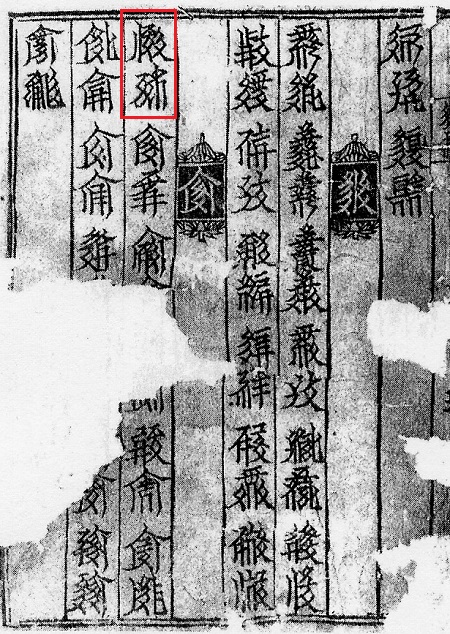
Mixed Characters folio 5B column 6
On the right side of K3:30 we can make out the left edge of the character that precedes 𗆃𗉖, and it comprises two vertical strokes, so may well be the character 𘇇 mbi̯u 'elephant' which forms the word 𘇇𗅷 'elephant ivory' as the final entry for the preceding section (𘏨 ldi̯ə̣ 'treasure') of Mixed Characters. This confirms that the practice piece is copying the text of Mixed Characters.
C. Other Tangut Texts
Aside from the lexical texts discussed above, the only non-Buddhist Tangut texts discovered in the caves were a small handful of manuscript fragments which enumerate grain supplies, and a single complete medicinal recipe. One of the fragments (K2:92) may be the only dated item found, as it includes the words "10th ... of the Great Virtue era" 𘜶𗣼𗰗... (Chinese 大德十... Dàdé shí...), although unfortunately the four following characters are missing. However, the Great Virtue era only lasted five years, from 1135 to 1139, so these words cannot refer to the 10th year of the era.
C. 1 Medicinal Recipe
A small sheet of paper with a complete medicinal recipe written on it was found in Cave K2. The handwriting is reasonable legible, and I transcribe and translate it below the image. The recipe is evidently translated from Chinese as the ingredients are all transcriptions of Chinese words in Tangut characters. The catalogue (Shānzuǐgōu Xīxià Shíkū vol. 1 p. 234) transcribes the title of the recipe into Chinese characters as 曼遮散 màn zhē sǎn, and notes that this must be the Tangut phonetic transcription of some Tibetan or Sanskrit word of unknown meaning. This is a little strange because 散 sǎn is the standard term in traditional Chinese medicine for powered medicine, and is used in the names of other Tangut medicinal recipes. Actually, 曼遮散 is not a correct transcription, and the three Tangut characters should be read as 𗩩𗦮𘋅 wân phɪn san, which is a transparent transcription of the Chinese 萬病散 wàn bìng sǎn 'powdered medicine for ten thousand ailments'.
K2:197
Shānzuǐgōu Xīxià Shíkū Plate CCXCV
𗩩𗦮𘋅
𗣩𗘍𗴂𘆄𗗙𗇐
- 𗺹𗫲𗒫𗥃𗍬
- 𗽰𗐐𗏁𘔭
- 𗥻𗫲𗒫𗍫𗍬
- 𗐺𘊴𘕕𘔭
- 𗶡𗜀𗍫𘔭
- □□𗢛𗤁𘔭
- 𘋅𗥻𗁡𘕕𘔭
𘌽𘜔𗓎𗀽𘆩𗡱𘃡。𗒾𗿳𘈩𗲁𗊖𘂤𗏁𘔭𘍾𗂹𗠰𗦇,𗥃𗏁𘎐。
𗋟𘅍,𘌐𗴂□□□𘕕𘎐𗠰𗦇。
𗏁𘔭𘘣𗫂□□□□□𗦾𗦇。
Many of terms in the Tangut text are direct transcriptions from Chinese, and in these cases the corresponding Chinese characters are given in braces in the English translation. The weights are given as 𗍬 (li̯u) = Chinese 兩 liǎng 'ounce', and 𘔭 (ndzi̯e) = Chinese 錢 qián 'dram', with 10 drams = 1 ounce.
Powdered medicine for ten thousand ailments {萬病散}
Cure for green and white phlegm¹ {痰} etc.
- Yellow² Semen Pharbitidis {黄牽牛} : 4 ounces
- Ink fragrance³ {墨香} (?) : 5 drams
- White Semen Pharbitidis {白牽牛} : 2 ounces
- Cuscuta chinensis⁴ {門菟} (?) : 3 drams
- Black pepper {胡椒} : 2 drams
- Taro⁵ {芋} : 6 drams
- White mulberry bark⁶ {桑白皮} : 3 drams
Take these amounts and grind them together into a fine powder. Before going to sleep, put five drams in a cup of wine,⁷ then stir vigorously and drink up.⁸ Four or five doses [should be sufficient] (or [enough for] four or five doses).
[The last two sentences are difficult to understand properly because of damaged and missing text.]
When it is awry (i.e. if there are side effects?), white rice ... eat three doses.
What is meant by five drams, ... should watch.
Notes
¹ Shānzuǐgōu Xīxià Shíkū p. 234 transcribes the Tangut characters 𗣩𗘍𗴂 tha ngwə̣ phôn as 白佗青 bái tuó qīng 'white tuo qing' (?), but the two native Tangut colour words 𗘍𗴂 ngwə̣ phôn 'blue-green and white' should jointly modify the preceding character 𗣩 tha. In Pearl in the Palm 𗼇𘂜𗟲𗿳𗖵𘃎𘇂𗊏 mi źạ ngwu ndzi̯e mbi̯u pi̯ạ ngu ni̯e (Chinese Fān-Hàn Héshí Zhǎngzhōngzhū 番漢合時掌中珠) the Tangut character 𗣩 tha is a phonetic gloss for Chinese 桃 táo, 道 dào, 毯 tǎn, 貪 tān, 踏 tà, etc., and so my best guess is that it here represents Chinese 痰 tán 'phlegm'.
² In Pearl in the Palm the Tangut character 𗺹 xeɯ is a phonetic gloss for Chinese 後 hòu 'behind', 厚 hòu 'thick, 喉 hóu 'throat', etc., but none of these characters or other Chinese characters pronounced hou are obvious modifiers for the plant name. I therefore follow the transcription as 黄 huáng 'yellow' given in Shānzuǐgōu Xīxià Shíkū p. 234, even though the phonetic correspondence is not perfect.
³ This follows the transcription of 𗽰𗐐 mbu xi̯on as 墨香 mò xiāng 'ink fragrance' in Shānzuǐgōu Xīxià Shíkū p. 234. I am not sure whether 'ink fragrance' is an attested ingredient of Chinese medicine, but I suppose it is plausible, and certainly more likely than the alternative reading of 𗽰𗐐 as 'tomb fragrance'.
⁴ Shānzuǐgōu Xīxià Shíkū p. 234 transcribes 𗐺𘊴 men thu as 門土 mén tǔ 'doorway dirt' which does not seem to be an ingredient of Chinese medicine as far as I can tell. I think it is plausible that 𘊴 thu is intended to transcribe Chinese 菟 tù (i.e. the seeds of the Chinese dodder vine, Cuscuta chinensis). However, I do not know what the prefix 𗐺 men (= 門 mén 'door, gate' ?) signifies (is 燜 mèn 'braised' a possibility?).
⁵ The Tangut character 𗢛 ꞏi̯u 'ghost' is probably a transcription for Chinese 芋 yù, but the two preceding characters are damaged and not clearly legible. We could probably read the Tangut characters if we could guess what the corresponding three-character Chinese name was.
⁶ Shānzuǐgōu Xīxià Shíkū p. 234 transcribes 𘋅𗥻𗁡 san phê phi as 散白皮 sǎn bái pí, but 桑白皮 sāng bái pí seems more likely as it is the name of a recognised ingredient for Chinese medicine.
⁷ The authors of Shānzuǐgōu Xīxià Shíkū evidently read 𗊖 ꞏo 'wine' as 𗊰 li̯wu 'bottle' because they give the Chinese translation as 瓶 píng 'bottle'. however, the character definitely looks like 𗊖 rather than 𗊰, and I think 'wine' makes more sense.
⁸ The Tangut text has the verb 𗂹 lhi̯ə̣ 'to beat, to thrash' before 𗠰 thi 'to drink', but it is omitted in the Chinese translation in Shānzuǐgōu Xīxià Shíkū p. 234. I think that 𗂹 is here an instruction to stir vigorously in order to dissolve the medicine.
D. Non-Tangut Texts
The vast majority of texts discovered in Shanzuigou caves K1, K2, and K3 are in the Tangut script. There is a single manuscript fragment in mixed Tangut and Chinese scripts (K2:134), although only a couple of dates are in Chinese so it is not that exciting. There are also a handful of fragments of manuscripts and woodblock editions of Chinese text, but nothing out of the ordinary. All the remaining non-Tangut items are discussed below.
D.1 Tibetan
A single small fragment of a manuscript written on both sides in cursive 'headless' Tibetan script was found in Cave K2.
K2:426 (front)
Shānzuǐgōu Xīxià Shíkū Plate CCLXXXVII (1)
K2:426 (back)
Shānzuǐgōu Xīxià Shíkū Plate CCLXXXVII (2)
D.2 Sanskrit Dharani
Also in Cave K2 were found ten complete and partial copies of the same woodblock printed rectangular sheet of Sanskrit dhāraṇī on two lines (complete sheet is about 25 × 6 cm in size). In form they are very similar to the oblong prayer flags that can still be seen today in Tibet, which are printed twice on a double-length strip of paper that is folded over for hanging from a line (some examples from my collection). Note that the colour plates in the catalogue show the text reversed for K2:235-1, 2 and 3 (Plate CCLXXXVIII), so I have mirrored the images so that the text is the right way round.
K2:235-1
Shānzuǐgōu Xīxià Shíkū Plate CCLXXXVIII (1)
K2:235-2
Shānzuǐgōu Xīxià Shíkū Plate CCLXXXVIII (1)
K2:235-3
Shānzuǐgōu Xīxià Shíkū Plate CCLXXXVIII (1)
K2:6
Shānzuǐgōu Xīxià Shíkū Plate CCLXXXIX
The catalogue (Shānzuǐgōu Xīxià Shíkū vol. 1 p. 230) states that these pieces are written in the Tibetan script, which is obviously not the case. They are actually written in a form of Nāgarī script. It has been hard to find similar examples of Sanskrit dhāraṇī printed on an oblong strip from this period, but below is the Dhāraṇī of Thousand-Turning and Eliminating Sins of the Sacred Avalokiteśvara from the Mogao Caves at Dunhuang, which is surrounded by eleven oblong strips printed with a dhāraṇī for protection during chidbirth (救產難陁羅尼), written in Siddhaṃ script with Chinese characters:
Sanskrit dhāraṇī sheets from Dunhuang
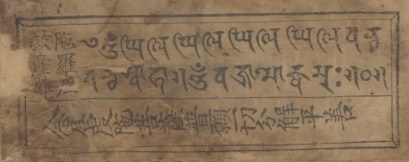
Chinese: 救產難陁羅尼 (left of Sanskrit text)
Sanskrit (reading by Viacheslav Zaytsev):
@ om̐ ghili ghili ghili ghili bandha bandha svāhā || om̐ vajra mokṣa muḥ || ○ ||
Chinese: 念尼虔陁菩薩普願一切分解平善 (below Sanskrit text)
As the printed text of the dhāraṇī found at Shanzuigou is unclear in many places (either too lightly inked or too heavily inked) it is not easy to read the text, but my collaborator Viacheslav Zaytsev has done a fantastic job of identifying and reading the text. The text is the Mālāmantra (Chinese 華鬘真言 huámán zhēnyán) from the Āryyoṣṇīṣavijayāsādhana (Uṣṇīṣavijayāsādhana). It is also known in a longer, extended form as the Fundamental dhāraṇī of the Amitābha Tathāgata (Chinese 阿彌陀如來根本陀羅尼 ēmítuó rúlái gēnběn tuóluóní, 阿彌陀大陀羅尼 ēmítuó dà tuóluóní or 阿彌陀佛根本咒 ēmítuófó gēnběn zhòu), but this one is clearly closer to the text from he Uṣṇīṣavijayāsādhana than to the Amitābha dhāraṇī. Our reading (with corrections) is:
om̐ amite amitodbhave amitavikrāṃte ami[ta]gātre amitagāmine amita-āyurdade gaganakīrtikari sarvakleśakṣayaṃkarīye svāhā ||
This may be compared with the version given in the Sādhanamālā (no. 211 Āryyoṣṇīṣavijayāsādhana on p. 418):
om̐ amite amitodbhave amitacakrānte amitagātre amitagāmini amitāyurdade gaganakīrttikari sarvvakleśakṣayaṃkarīye svāhā
A detailed transcription and commentary of the dhāraṇī on the Shanzuigou examples is provided below. Problematic, doubtful or mistaken akṣaras are marked with an asterisk.
| No. | Reading | Images | Commentary |
|---|---|---|---|
| 1 | om̐ |


|
'om̐' with anunāsika (candrabindu) |
| 2 | a* |



|
Our specimens for this akṣara are unclear, but it seems that either another form of the 'a' akṣara is printed, or the 'dya' or similar akṣara (with -va or -ya conjoint) is mistakenly printed instead of 'a', cf. with form of 'svā' (no. 49) that lets us exclude it. Clearer examples would allow us to reach a conclusion as to whether it is a printing error or not. |
| 3 | mi |



|
Two forms of this word are attested in versions of this dhāraṇī: 'amita' and 'amṛta' (some researchers list 'amrita' and even 'amṛita' as well, extending 'ṛ' to 'ṛi' in transliteration, but we could not find original texts to confirm these). There are a few occurrence of this akṣara in the text (nos. 3, 6, 11, 17, 21 and 27), and, although they are mostly not clear, it is possible to conclude that it is 'mi' not 'mri' (or 'mṛi'). Cf. with clear form of 'mi' (no. 22). |
| 4 | te |


|
Graphic form of <t> akṣaras (no. 4, 7, 12, 15, 22, 28) in this print look like if they were <tr>, but they are clearly not. |
| 5 | a |



|
|
| 6 | mi |



|
There is no good example of the akṣara in this position in the preserved copies. Possibly it was printed with an error in its graphic form (cf. with the same situation in no. 11). We restore it according to the sense and visible parts. See commentary for no. 3. |
| 7 | to |


|
See commentary for no. 4. |
| 8 | dbha |

|
It is possible that this akṣara is 'ddha' printed mistakenly for 'dbha', not actually 'dbha' itself. The text does not contain other <bh> or <dh> akṣaras so we cannot check this possibility by comparing the graphic forms. 'dbha' is the correct reading in this word. |
| 9 | ve |

|
|
| 10 | a |

|
|
| 11 | mi |

|
There is no good example of the akṣara in this position in the preserved copies. Possibly it was printed with an error in its graphic form (cf. with the same situation in no. 6). We restore it according to the sense and visible parts. See commentary for no. 3. |
| 12 | ta |

|
See commentary for no. 4. |
| 13 | vi |



|
|
| 14 | krāṃ* |



|
It seems that there is an error in the printing of this akṣara, with 'aṃ' is printed instead of 'krāṃ', which is visually similar and could confuse the scribe or engraver, but we have no clear example to examine in detail and determine whether there an error in the printing or not. Anusvāra here represents nasal dental 'n' = 'krān'. |
| 15 | te |


|
See commentary for no. 4. |
| 16 | a |


|
|
| 17 | mi |


|
See commentary for no. 3. |
| 17a | [ta]* | See commentary below. | |
| 18 | [?]ā* |



|
Nos. 18–19 are unreadable by us. Other versions have "a mi ta gā tre" and "a mi ta ga te" for nos. 16–19. Here is expected 'ta' continuing "a mi" (nos. 16–17), but the akṣara does not look like 'ta'. Also there are two akṣaras instead of the expected three ("ta gā tre" or "ta ga te"). Another contemporary Sanskrit source we found uses the same graphic form (with the subscripting 'r'-like feet, see our commentary for no. 4) for the akṣara representing 'dī' (sic!), but it could be a printing error, because it definitely looks like the akṣara 'dā' although 'dī' would be expected (cf. with the same 'ī/ā' error at no. 47 and with different form of <d> akṣaras in this print at nos. 31–32). In conclusion, it may be the result of missing/mistaking one akṣara while carving or mixing two ("ta gā" or "ta ga") into one. |
| 19 | [?r?]e* |


|
Unreadable. Possible 'tre', but look like 'gre'. See commentary for no. 18. |
| 20 | a |



|
|
| 21 | mi |


|
See commentary for no. 3. |
| 22 | ta |


|
See commentary for no. 4. |
| 23 | gā |


|
|
| 24 | mi |


|
|
| 25 | ne |


|
Note that other versions of this dhāraṇī have "gāmini" for nos. 23–25. |
| 26 | a |


|
|
| 27 | mi |


|
It seems that there is an error in the printing of this akṣara (cf., for example, with no. 24). See commentary for no. 3. |
| 28 | ta |

|
See commentary for no. 4. |
| 29 | ā |


|
|
| 30 | yu |




|
There is no good example of the akṣara in this position in the preserved copies. Possibly it was printed with an error in its graphic form (there is no visible traces of '-u' vowel, no vertical stroke of <y> akṣara). We restore it according to the sense and visible parts. |
| 31 | rda |


|
|
| 32 | de* |



|
It seems that there is an error in the printing of this akṣara, with 'di' is printed instead of 'de', which is visually similar and could confuse the scribe or engraver. |
| 33 | ga |

|
|
| 34 | ga |

|
|
| 35 | na |

|
|
| 36 | kī |

|
|
| 37 | rti* |

|
There is no good example of the akṣara in this position in the preserved copies. According to other versions of this dhāraṇī can be 'rti' or 'rtti'. Our reading is doubtful until good copy found. |
| 38 | ka |

|
There is no good example of the akṣara in this position in the preserved copies. We restore it according to the sense and visible parts. |
| 39 | ri |

|
There is no good example of the akṣara in this position in the preserved copies. We restore it according to the sense and visible parts. |
| 40 | sa* |

|
There is no good example of the akṣara in this position in the preserved copies. According to other versions of this dhāraṇī two akṣaras nos. 40–41 should be read as 'sa rva' or 'sa rvva'. Our reading of nos. 40–41 is doubtful until a good copy is found. |
| 41 | rva* |

|
There is no good example of the akṣara in this position in the preserved copies. See commentary for no. 40. |
| 42 | kle* |

|
According to other versions of this dhāraṇī the two akṣaras nos. 42–43 should be read as 'kle śa'. In our opinion, the graphic form of this akṣara does not fit with the graphic form of the akṣara 'kle'. However, it could be a correct form of 'kle', but with a reduced form of 'l', as can be seen in some other Sanskrit block print. Other sources and examples from the same period would allow us to reach a conclusion as to whether it is a printing error or not. |
| 43 | śa* |

|
It is impossible to say whether this may be 'sa' by mistake, as there are no other examples of 'śa' in the text. See commentary for no. 42. |
| 44 | kṣa |


|
|
| 45 | yaṃ |


|
Anusvāra here represents nasal velar 'ṅ' = 'yaṅ'. |
| 46 | ka |


|
|
| 47 | rī* |


|
It seems that there is an error in the printing of this akṣara, with 'rā' or 'ga' is printed instead of 'rī', which is visually similar and could confuse the scribe or engraver (cf. with <r> akṣaras: no. 39; with <g> akṣaras no. 23, 33, 34). |
| 48 | ye |



|
The akṣara 'ye' here looks similar to the akṣara 've' (no. 9), cf. with form of the 'yu' and 'yaṃ' akṣaras (nos. 30 and 45). |
| 49 | svā |



|
|
| 50 | hā* |




|
It is impossible to read this akṣara correctly using any of the copies we have. However, a careful and detailed examination lets us conclude that it is not 'sa' (which it looks like), but is the expected and correct 'hā'. |
| 51 | || |


|
D.3 An Unknown Script
A small piece of paper found in Cave K3 is perhaps the most interesting discovery of all, but strangely has attracted little attention.
K3:45
Shānzuǐgōu Xīxià Shíkū Plate CCCXXXII (2)
The catalogue entry merely states that it is "Tibetan script", and says no more about it. But really, this is not any standard form of Tibetan script, nor is it any form of unusual or esoteric Tibetan writing I have ever seen (nothing like it is listed in Lokesh Chandra's 1982 Indian Scripts in Tibet). In fact, I have never seen anything like it before, and to me at least it is a completely unknown script.
Catalogue entry for K3:45

Shānzuǐgōu Xīxià Shíkū vol. 1 p. 282
The orientation shown in Plate CCCXXXII seems to be correct, in which case the script is written in horizontal lines. As explained in the 2nd bullet point below, I think that the signs were probably written left-to-right like Brahmic scripts. For ease of discussion I number the individual signs as shown below (dots between signs are labelled as the preceding sign number with a star):
K3:45 with signs numbered
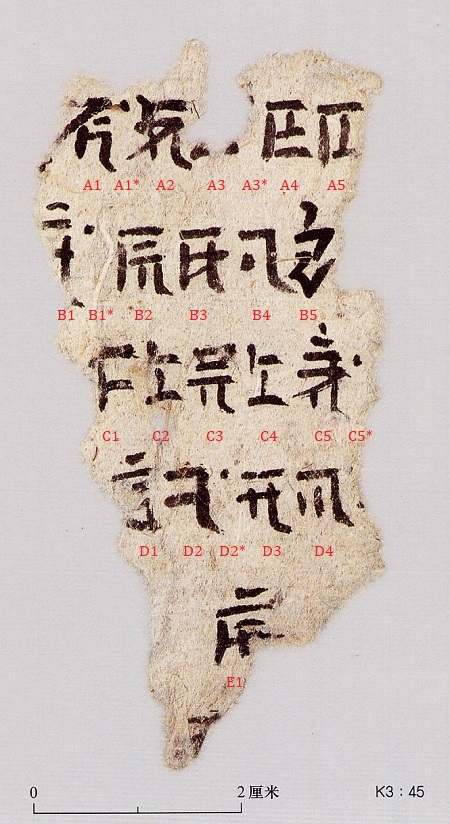
It looks to me as if it could be a strange form of Brahmic script or have been created in imitation of a Brahmic script, although the individual signs are not recognizable as letters from any Brahmic script that I am familiar with. I don't want to make any wild guesses about the script or what exactly each sign represents, but here are some general observations:
- The signs appear to be written in horizontal rows, which means that they are unlikely to be based on a Sinitic script such as Khitan Large Script as Sinitic scripts were normally always written in vertical columns;
- Many of the signs show a right-curving swash at the end of a vertical stroke on the right side (A1, A2, B3, B4, C3, D2, D3, D4), which are probably the final stroke of the sign, suggesting that the from the left side to the right side, in which case the script is most likely to have been written left-to-right;
- There are three raised dots between signs (A1*, B1*, C5*, D2*), which looks like a Tibetan intersyllabic separator mark (tsheg) — it occurs too infrequently to mark syllable divisions, but could perhaps be a word or sentence separator;
- A few signs (B1, B5, D1, E1) have superfixed marks which may be vowel signs, but there are too few for these to be the only indicators of vowels (D1 and E1 look similar to a Tibetan 'o' vowel sign, and B5 looks similar to a Tibetan 'i' or 'e' vowel sign);
- The two strokes above C5 look like a candrabindu, and the whole sign feels like it should be om̐ or hūm̐;
- There are some signs which have the outer structure with different internal components (A4, A5, B2, B3; B4, D4), which may suggest that the outer structure and the internal components each have separate phonetic purposes (maybe representing consonants and vowels);
- There are a couple of recurring internal components (A5, C2/C4; B2, C3) which may have the same phonetic purpose;
- There seem to be incremental patterns in some of the internal components (𝍥 inside A5, but 𝍦 inside A4; two vertical lines inside D4, but two horizontal lines over two vertical lines inside B2), which may suggest that the glyphs were designed logically, with series of shapes made from dots, horizontal lines and vertical lines corresponding to series of phonetic values;
- Only one sign occurs more than once (C2 and C4), which may indicate that the signs are not alphabetic, and are more likely to be syllabic.
Individual signs may look similar to (or possibly derivable from) some specific letter or character in another script, but as far as I can tell there is no consistent correspondence between the signs on this manuscript fragment and any other known script. I have to admit that some of the signs do look somewhat Tangutesque, for example B2 and C3 which both incorporate a sign which looks like the Tangut component 𘡢, and especially B5 which is similar to the Tangut components 𘠠 or 𘡒, however on the whole I do not think the signs are derived from the Tangut script or from Tangut components. Perhaps the way that B5 is written just reflects the fact that the scribe was a Tangut monk. We can compare the signs on this manuscript fragment with the "thirty letter signs" derived from Tangut components which are listed in the Homonyms (Essential Selection of Often-Transmitted Homonyms and Mixed Characters 𘄴𘏲𗏹𘈧𗦻𘙰𗏇𘉅 tshi tsɪ̣ ꞏi̯u ndai mi̯e leɯ ndi ndza), and the obvious difference to me is the lack of any diagonal strokes (in K3:45) which are ubiquitous in the Tangut script.
Thirty Letter Signs in Homonyms

Homonyms folio 4A
If, as I suspect, this is a previously unknown and unrecorded script, then I think the most likely explanation is that it is the creation of one or more Tangut Buddhist monks at the Western Xia monastery at the Shanzuigou site. Perhaps the monks devised a special cryptic script loosely based on a Brahmic model so that esoteric knowledge could be protected, and only passed on to the few monks who were taught it. We have noted that the sign C5 looks as if it has a candrabindu on top, so may be the Sanskrit syllable oṃ or hūṃ, so perhaps the script was used for writing Sanskrit dhāraṇī. As C5 is followed by a raised dot, it is more likely to represent hūṃ (frequently occurs at the end of a mantra) than oṃ (frequently occurs at the start of a mantra), in which case line C may be a mantra ending ... X Y X hūṃ (where X is the same syllable). Certainly there are Sanskrit mantras which do fit this pattern. For example, in the Auspicious Tantra of All-Reaching Union the Sansktrit mantra oṃ jra domsta varahāmokhu tramvatrava hūṃ is written in Tangut characters as 𗙫 𗱽𘃜 𗠠𘉑𗸹𘈪 𗍣𘃜𗶴𗚛𗴼 𘎤𘃜𘉑𗍣𘎤𘃜𗍣𗦀 (see the study of dhāraṇī in this text by Prof. Niè Hóngyīn 聶鴻音 in Bàisìgōu Xīxià Fāngtǎ pp. 425–435).
I am very grateful to Viacheslav Zaytsev for making a preliminary analysis of the structure of the signs in this fragment, and creating a grid that shows how each sign may have been constructed from a combination of two or three parts representing different phonetic components. The bottom parts of characters may represent consonants, whereas top parts of the characters may represent vowels (1st group) or other syllable modifiers (2nd group, which may be added to the 1st group). Note that A1, A2, B3, B5, C5, and E1 occur in more than one place in the table because there are different possible analyses of their structure. Although this is just a working hypothesis which cannot be verified until and unless additional samples of this script come to light, I do think that it is a very useful approach to undertanding the structure of the signs.
| Bottom Part of Character | Top Part of Character | |||||||||
|---|---|---|---|---|---|---|---|---|---|---|
| First Group | Second Group | |||||||||
|
|
|
|
|
|
|
|
|
|
|
|
B4 |
|||||||||
|
C1 |
D2 |
||||||||
|
D4 |
|||||||||
|
A5 |
C2 C4 |
||||||||
|
A4 |
|||||||||
|
D3 |
C3 |
||||||||
|
B2 |
A1 |
||||||||
|
B3 |
|||||||||
|
B3 |
|||||||||
|
A2 |
C5 |
C5 |
|||||||
A1 |
||||||||||
|
B5 |
B5 |
||||||||
| Damaged Characters | ||||||||||
| ? | E1 |
E1 |
||||||||
| ? | D1 |
D1 |
||||||||
| ? | B1 |
B1 |
||||||||
Bibliography
- Duàn Yùquán 段玉泉. "Wǔwēi Hàimǔdòng yízhǐ chūtǔ de liǎngjiàn Xīxià wénxiàn kǎoshì" 武威亥母洞遗址出土的两件西夏文献考释 [Analysis of two Tangut documents excavated from the Haimu Cave site at Wuwei]. Xīxià Xué 西夏学 [Xixia Studies] vol. 8 (October 2011): 127–133.
- Murata Jirō 村田治郎 (ed.), with contributions by Nishida Tatsuo 西田龍雄 et al. Kyoyōkan 居庸關 = Chü-Yung-Kuan: The Buddhist Arch of the Fourteenth Century A.D. at the Pass of the Great Wall Northwest of Peking. [Kyōto]: Kyōto University Faculty of Engineering, 1957.
- Níngxià Wénwù Kǎogǔ Yánjiūsuǒ 宁夏文物考古研究所 (Ningxia Institute of Cultural Relics and Archeology). Bàisìgōu Xīxià Fāngtǎ 拜寺沟西夏方塔 = Xixia Quadrilateral Pagoda in the Baisigou Valley. Běijīng: Wénwù Chūbǎnshè 文物出版社 (Cultural Relics Press), 2005. ISBN 978-7-5010-1727-0
- Níngxià Wénwù Kǎogǔ Yánjiūsuǒ 宁夏文物考古研究所 (Ningxia Institute of Cultural Relics and Archeology). Shānzuǐgōu Xīxià Shíkū 山嘴沟西夏石窟 = Xixia Grottoes Temple in Shanzuigou Valley. Běijīng: Wénwù Chūbǎnshè 文物出版社 (Cultural Relics Press), 2007. ISBN 978-7-5010-2219-9
K3:109
Shānzuǐgōu Xīxià Shíkū Plate CCCXXXI (1)
Fragment of a thangka painting of Vajravārāhī from Cave K3
𗍥𘟙𗘅𗴺 ꞏi̯ə̣ nɪn ngi̯u ma
རྡོ་རྗེ་ཕག་མོ rdo-rje phag-mo
金剛亥母 jīngāng hàimǔ
Last modified: 2021-02-01
Manuscripts | Sanskrit | Tangut | Tibetan
Index of BabelStone Blog Posts
